Casa owner Tony arranged for an English speaking pro guide called Mario to come and have a chat with me on the Tuesday after we arrived to formulate a plan according to what I wanted to target. He was due at 8.00am so I stayed in until he arrived, frustratingly some time after 9.00am so I could have gone out after all! The chat lasted about 5 minutes during which time I was informed that my desired list of rails,crakes, nightjars wasn't likely to happen. I'd chosen all the species that I thought you would need specialist knowledge to find roosting spots or were likely to be seen in the Cienaga de Zapata, the National Park where an authorised guide is mandatory. No worries, I had much to see, I'd leave it in his capable hands what to show me. The only thing I wasn't bothered about was the Bee Hummingbird or Cuban Tody as I had already nailed the Tody and intended returning on my own for the hummer.
Few guides appear to have transport so a taxi might be necessary unless you have your own hire car which of course I did. Asking me what time I wanted to start I said as early as possible, to which he replied "8.00am?"
"First light sounds better" I replied but he told me he lived 35kms away and he would find it difficult to get to me earlier than around an hour later at7.00am. We agreed and off he went.
That evening Tony informed me Mario had rung to tell him there had been some confusion at the National Park office, a tour party had been double booked so he had to help out but that he would send a locally based guide who would be with me at 6.00am instead.
Only one small problem, he didn't speak English!
In a no choice situation I accepted and Gwilliam, which I think his name was, duly turned up at 6.00am and armed with a packed breakfast off we went. My first experience of driving in the dark in Cuba !
Heading south along the shores of the Bay of Pigs, we drove through Playa Giron and on another 10 kms or so where I got the message to pull over. We had drove in virtual silence but at least I could concentrate on the road ahead which turned out to be excellent. The only hazard was the one horse and cart that was going the opposite direction and completely unlit despite the pitch black !
Anyway, I was directed to cross the road and we walked a short distance in to the woods where a viewing screen had been erected as a permanent feature. We were greeted by someone else who presumably looks after the place and puts the food down to attract the target species, the rather attractive Blue-headed Quail-Dove, another endemic species that's a threatened species. Dawn had only recently broken so the light was poor but in the time we spent there it improved enough to get some reasonable images.
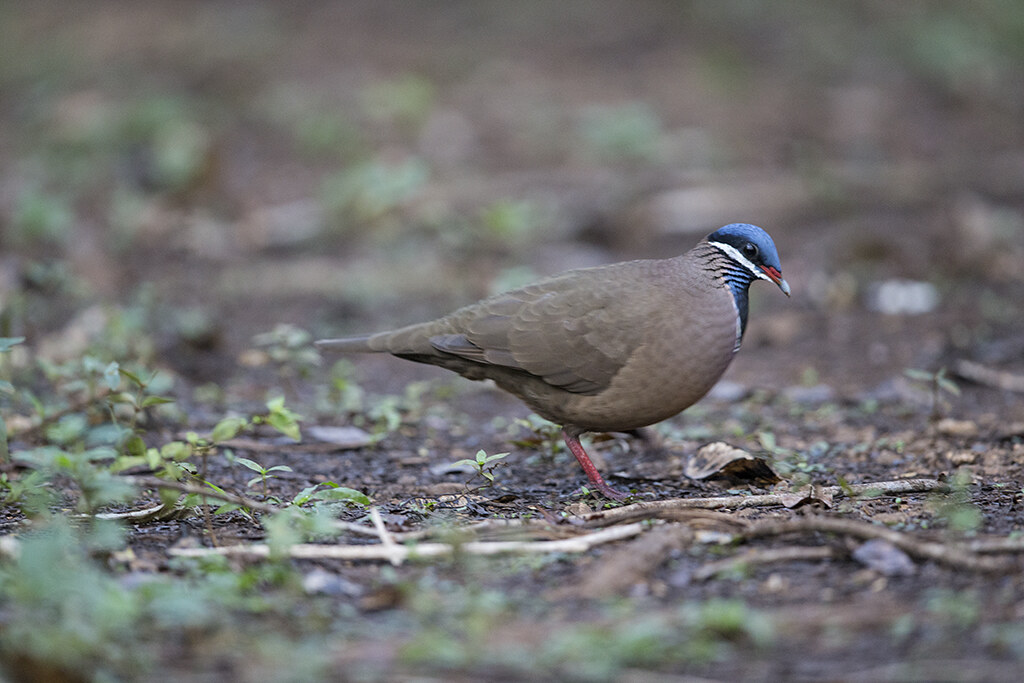 Occasionally stopping to take a bow of course!
Occasionally stopping to take a bow of course!
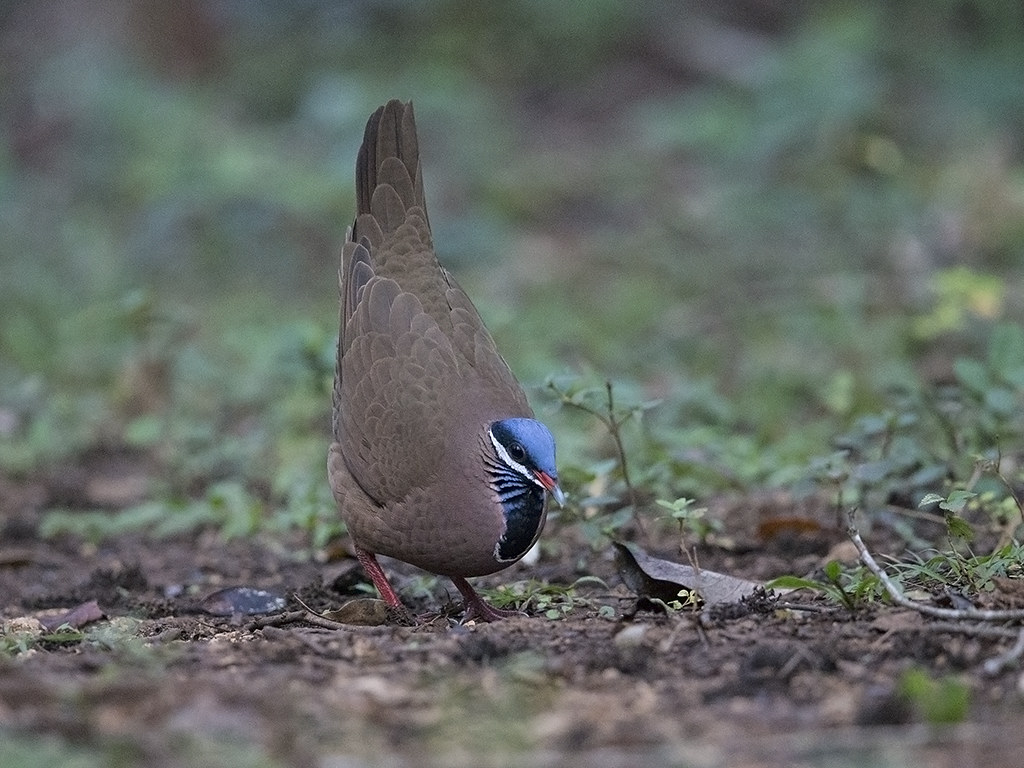 I'd managed enough conversation using various aids to indicate that Cuban Parakeet was a desired target and despite the fact Gwilliam told me they were difficult we got lucky and found a whole tree full of them just down the road from the doves.
I'd managed enough conversation using various aids to indicate that Cuban Parakeet was a desired target and despite the fact Gwilliam told me they were difficult we got lucky and found a whole tree full of them just down the road from the doves.
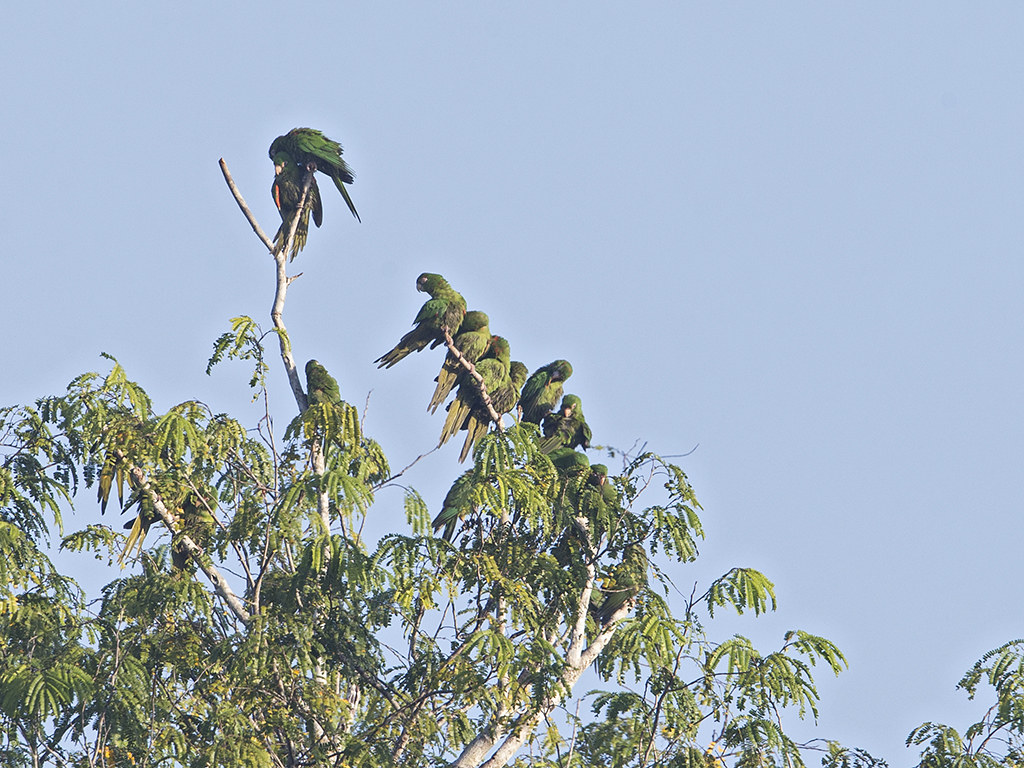 They all flew off but a couple returned very briefly to a much closer tree.
They all flew off but a couple returned very briefly to a much closer tree.
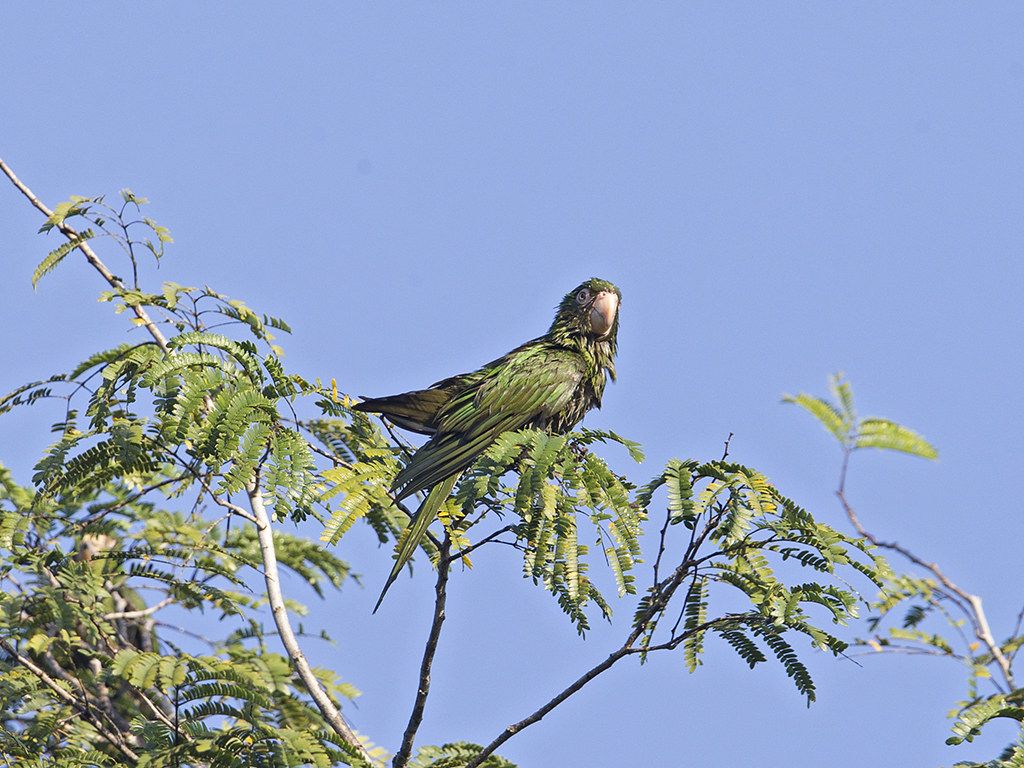 So decent views were had.
So decent views were had.
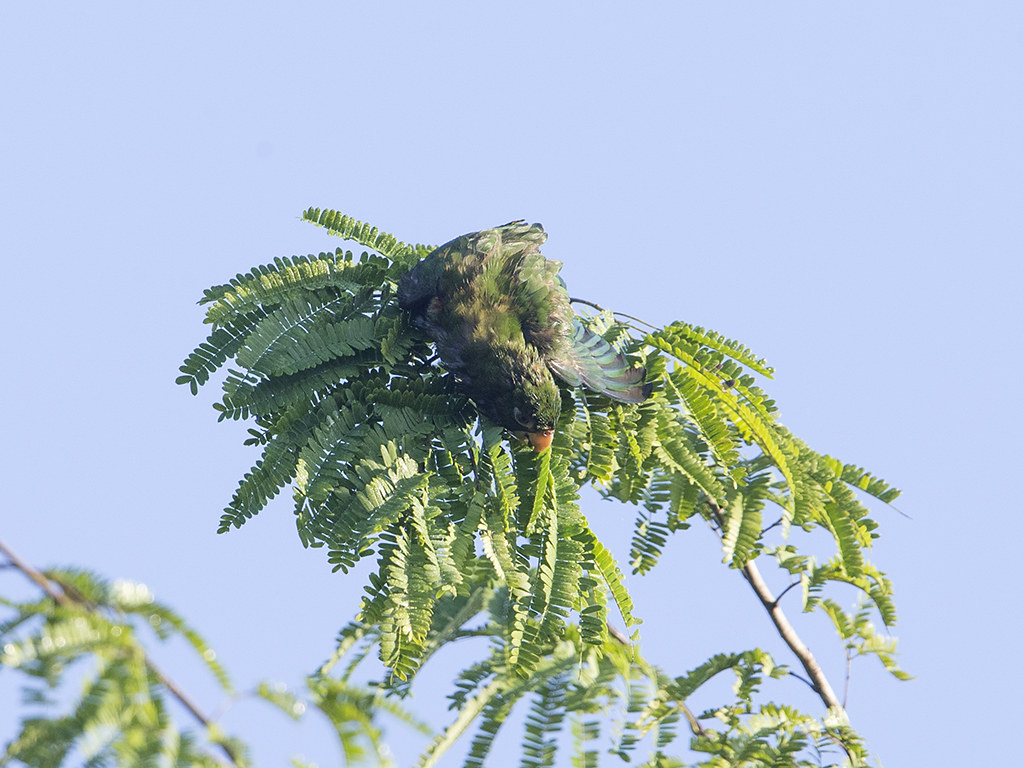 A decent start to the day!
We then headed back north stopping first at Punta Perediz where there is a very popular dive and snorkelling centre. I think you pay a fee to enter for which you get to use their sun beds and get a meal and drinks included in the price. We were very early and the first of the swimmers was yet to appear and they were happy for us to enter free of charge to check out a big tree in the middle of their ground to seek out the endemic Red-shouldered Blackbirds. There were quite a few in the tree, two flew out and you could clearly see the red shoulder patches when in flight, those that remained were apparently juveniles and their distinctive flashes have yet to appear.
A decent start to the day!
We then headed back north stopping first at Punta Perediz where there is a very popular dive and snorkelling centre. I think you pay a fee to enter for which you get to use their sun beds and get a meal and drinks included in the price. We were very early and the first of the swimmers was yet to appear and they were happy for us to enter free of charge to check out a big tree in the middle of their ground to seek out the endemic Red-shouldered Blackbirds. There were quite a few in the tree, two flew out and you could clearly see the red shoulder patches when in flight, those that remained were apparently juveniles and their distinctive flashes have yet to appear.
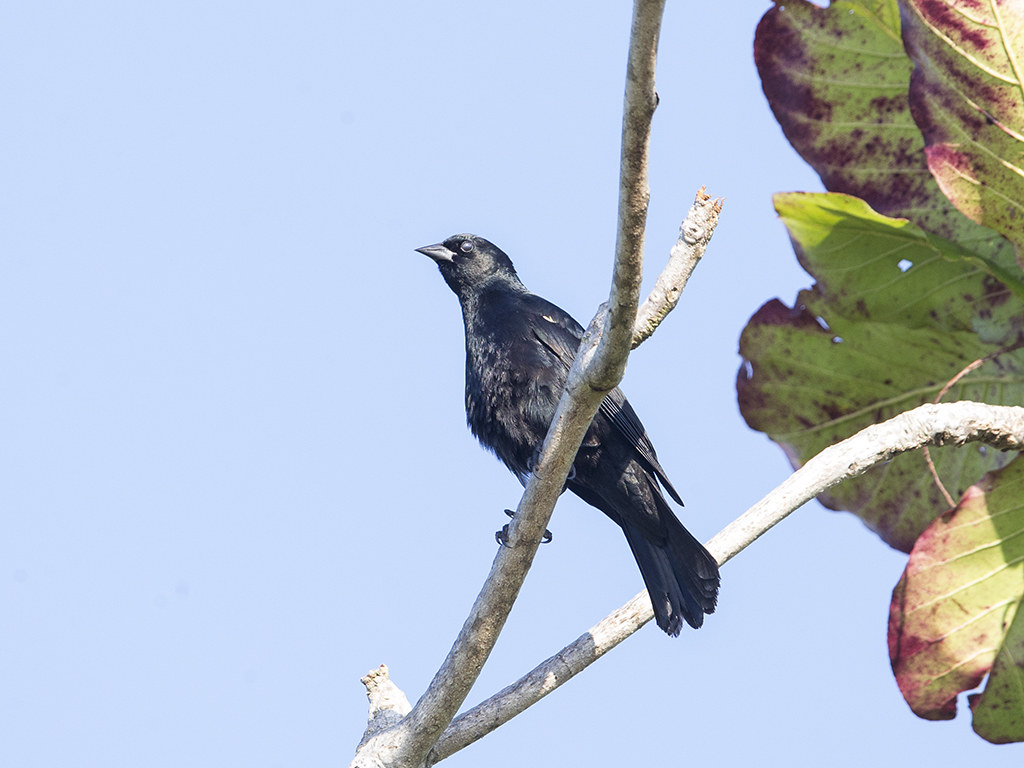 My photo barely shows anything at all!
Next it was on to another dive spot popular with day trippers. The Cueva de los Peces is an inland deep lagoon surrounded by woods.
My photo barely shows anything at all!
Next it was on to another dive spot popular with day trippers. The Cueva de los Peces is an inland deep lagoon surrounded by woods.
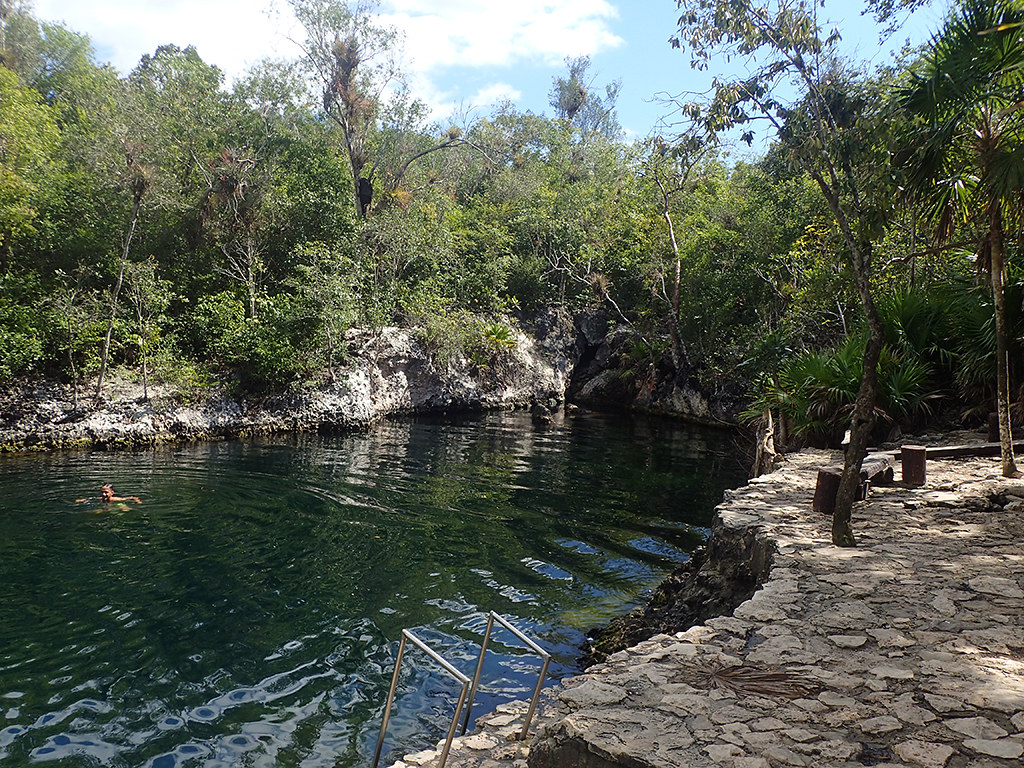 It's only about 50 metres from the road and the seashore but it has a restaurant and loos and get's very popular after 10am when the tour buses start dropping in.
We were there just before !
Using a bird caller, Gwilliam had an almost instant response from his target , the endemic Trogan.
It's only about 50 metres from the road and the seashore but it has a restaurant and loos and get's very popular after 10am when the tour buses start dropping in.
We were there just before !
Using a bird caller, Gwilliam had an almost instant response from his target , the endemic Trogan.
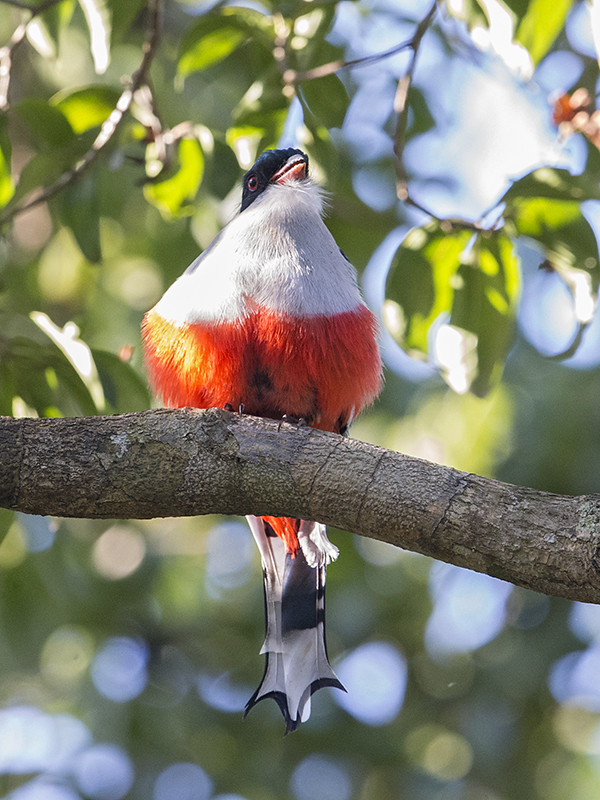 Puffed up, I would guess in response to a possible interloper, he made a difficult subject due to the lighting and surrounding trees.
Puffed up, I would guess in response to a possible interloper, he made a difficult subject due to the lighting and surrounding trees.
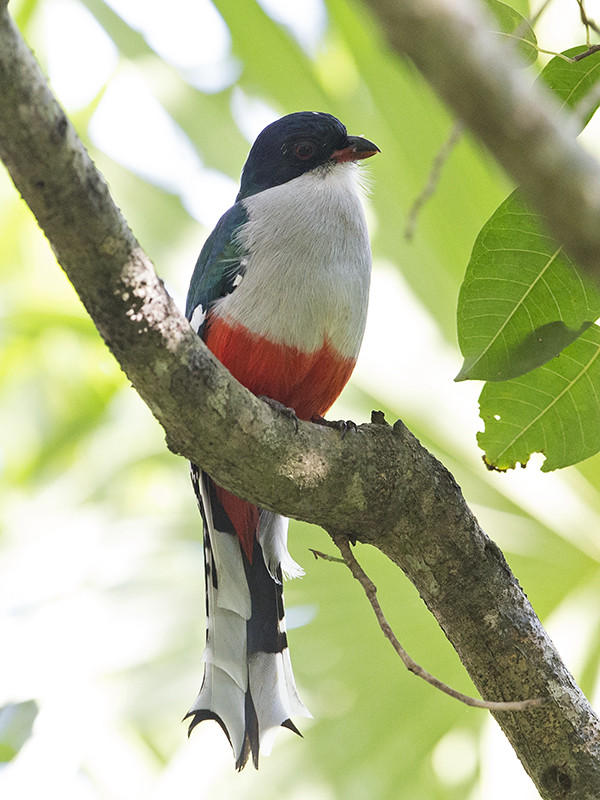 A stunning looker and Cuba's national bird, well has the colours of the flag so has to be!
From behind the blues take on a green appearance depending on the light.
A stunning looker and Cuba's national bird, well has the colours of the flag so has to be!
From behind the blues take on a green appearance depending on the light.
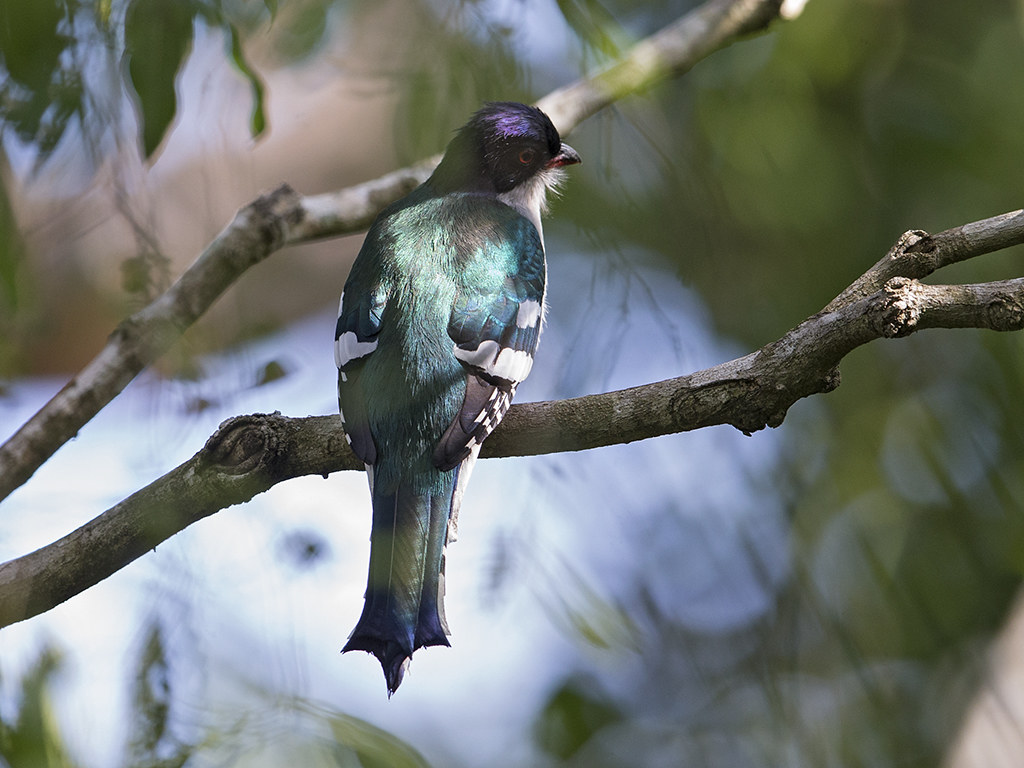 During a of couple attempts to lure the bird back in to a better position to photograph, another endemic, the Cuban GreenWoodpecker, flew through the woods.
I knew that it was a lost cause trying to capture a really good Trogan image so I requested an attempt at calling the 'pecker.
Another instantaneous result with not one but two of them!
During a of couple attempts to lure the bird back in to a better position to photograph, another endemic, the Cuban GreenWoodpecker, flew through the woods.
I knew that it was a lost cause trying to capture a really good Trogan image so I requested an attempt at calling the 'pecker.
Another instantaneous result with not one but two of them!
 They proved to be just as challenging in low light and shade, the camera allows you to enhance it greatly.
They proved to be just as challenging in low light and shade, the camera allows you to enhance it greatly.
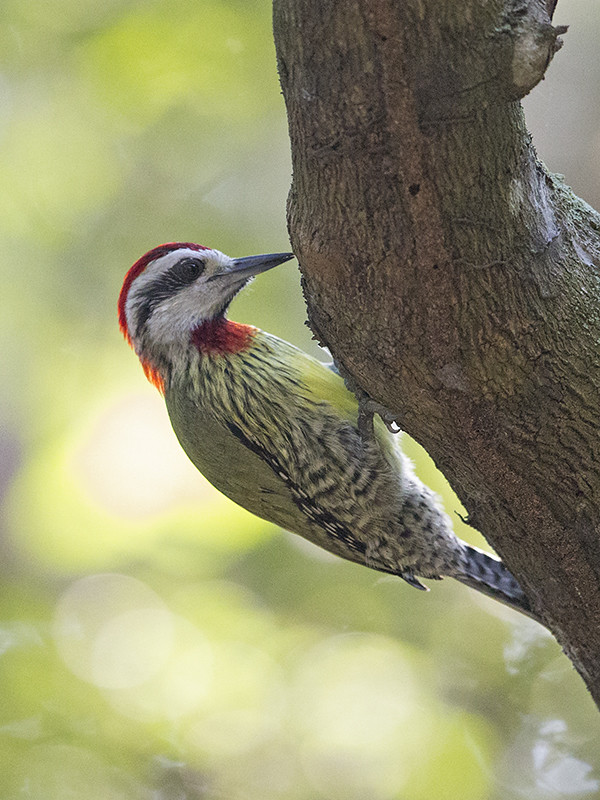 but with a bit of luck and a higher frame per second rate you are in with a chance of capturing an image where the motion blur isn't apparent.
but with a bit of luck and a higher frame per second rate you are in with a chance of capturing an image where the motion blur isn't apparent.
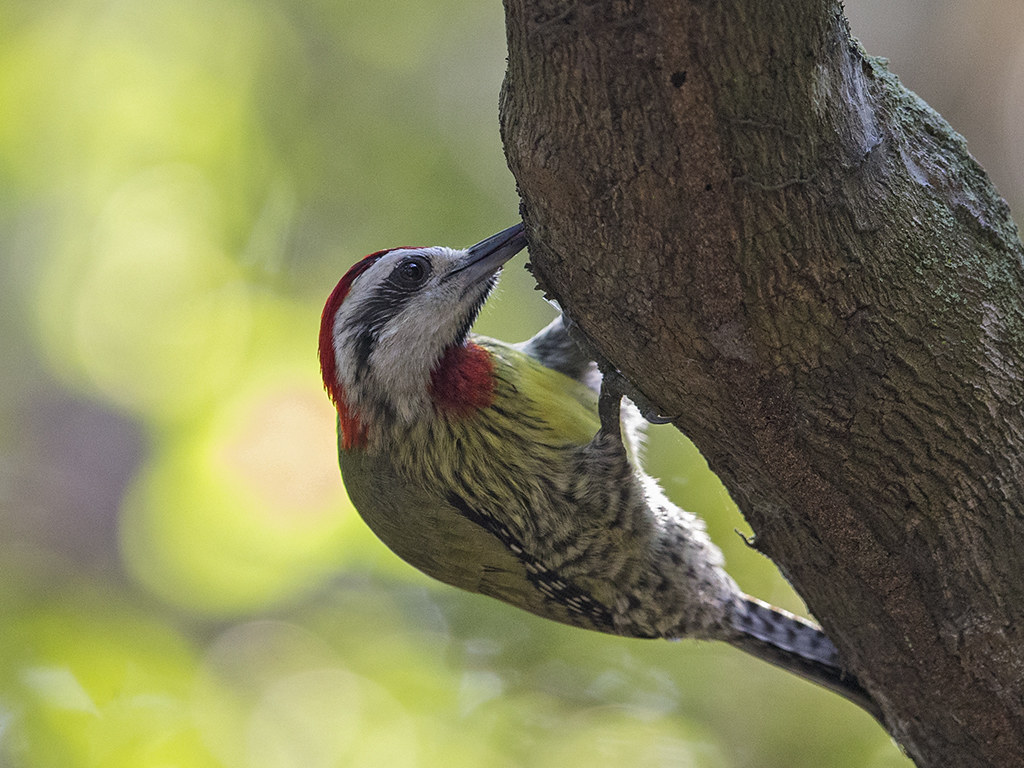 These weren't the only species around in the woods either. We had excellent views of a male American Redstart
These weren't the only species around in the woods either. We had excellent views of a male American Redstart
 A Black and White Warbler
A Black and White Warbler
 and my only Stripe-headed Tanager for the whole trip.
and my only Stripe-headed Tanager for the whole trip.
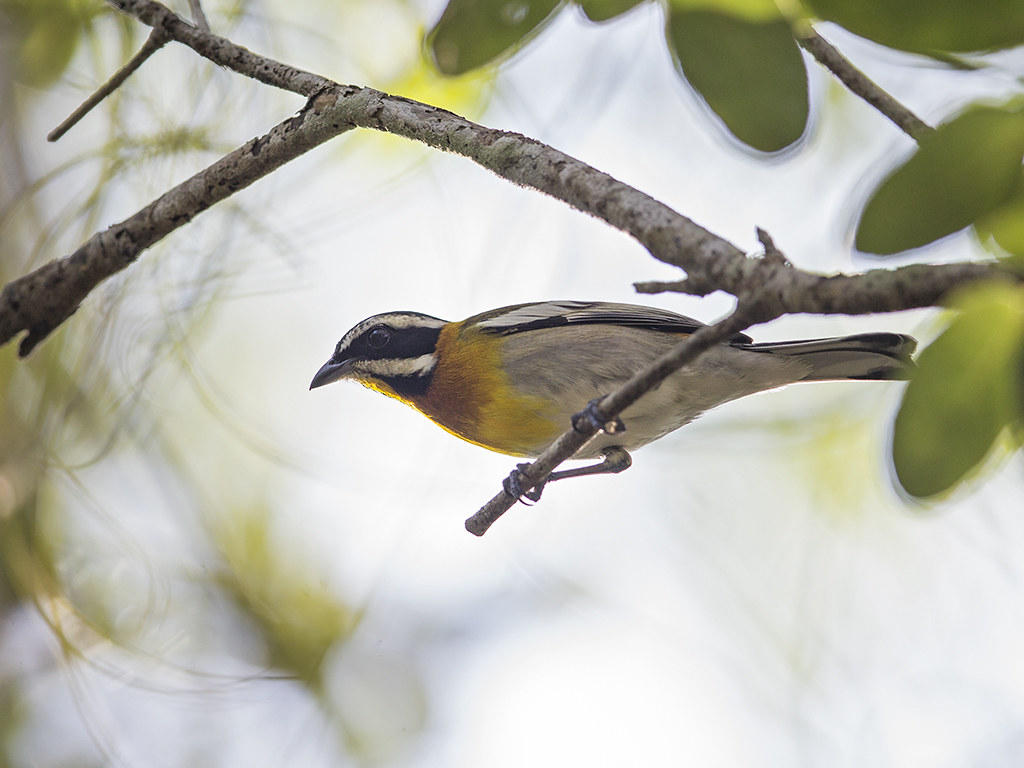 As the trippers were getting bigger in number we moved on and headed towards Sopillar, again! It was somewhere I felt comfortable wandering myself and really I wanted to go in to the National Park but Mario had dissuaded me so Sopillar it was. A favourite with all the guides it seems.
We went in from a different direction, this time from the south and on a tarmac'd road which was much better than the entrance to the north which I'd been using.
First tip and lesson learnt!
We headed in to a well wooded area taking the car as far as it was safe, or at least seemed safe, to do so, then got out on foot where we soon bumped in to another guide with his client. The client was very exited and showed us a shot of the Fernandina's Flicker he had taken. It was a distant shot taken with a small lens and he was extremely chuffed to have got it. The Flicker, another endemic, was on my target list too and I'd been studying the pictures in my guide book. The one in his picture I could have sworn had some red showing on it's head which would have made it a West Indian Woodpecker but I am a birding numpty so who was I to say anything.
I later discovered Gwilliam was also of the opinion it wasn't a Flicker either.
It poses the question of what the client might have thought when he eventually saw his shot on a big screen. Maybe to this day he hasn't realised and is happy in his record. Does it matter really ?
I leave you with your own thoughts!
Anyway, we came to the edge of the woods and infront of us a fairly heavily flooded field.
As the trippers were getting bigger in number we moved on and headed towards Sopillar, again! It was somewhere I felt comfortable wandering myself and really I wanted to go in to the National Park but Mario had dissuaded me so Sopillar it was. A favourite with all the guides it seems.
We went in from a different direction, this time from the south and on a tarmac'd road which was much better than the entrance to the north which I'd been using.
First tip and lesson learnt!
We headed in to a well wooded area taking the car as far as it was safe, or at least seemed safe, to do so, then got out on foot where we soon bumped in to another guide with his client. The client was very exited and showed us a shot of the Fernandina's Flicker he had taken. It was a distant shot taken with a small lens and he was extremely chuffed to have got it. The Flicker, another endemic, was on my target list too and I'd been studying the pictures in my guide book. The one in his picture I could have sworn had some red showing on it's head which would have made it a West Indian Woodpecker but I am a birding numpty so who was I to say anything.
I later discovered Gwilliam was also of the opinion it wasn't a Flicker either.
It poses the question of what the client might have thought when he eventually saw his shot on a big screen. Maybe to this day he hasn't realised and is happy in his record. Does it matter really ?
I leave you with your own thoughts!
Anyway, we came to the edge of the woods and infront of us a fairly heavily flooded field.
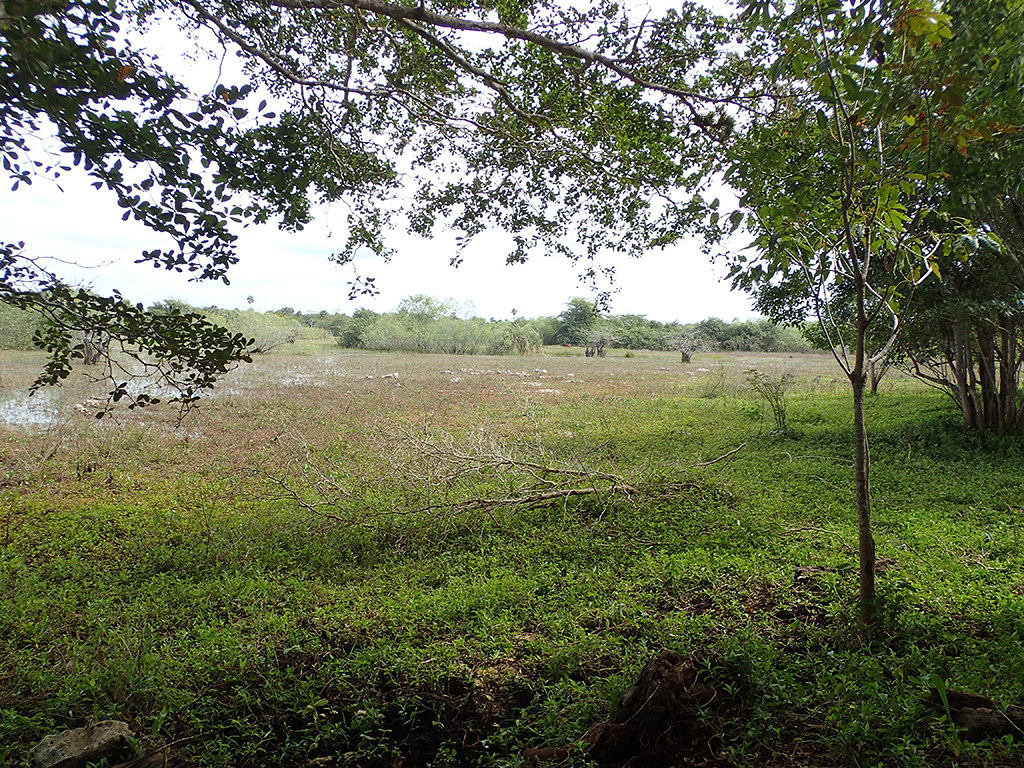 "Do you want to see if we can find a Cuban Screech Owl?" I was asked.
"You bet!" was my reply .
"Follow me then." was the instruction as he rolled up his trousers to reveal he was about to head off in to the swampy field with his trainers and socks on!
Wearing shorts and sandals, I just discarded the sandals and followed in bare feet.
Holding a big lens and camera in one hand and using my tripod as a walking stick to maintain balance I was able to keep up despite being up to my knees in water and my feet dragging through weed and roots on occasion. I even managed to sneak up on a pair of Jacanas using a tree for cover.
"Do you want to see if we can find a Cuban Screech Owl?" I was asked.
"You bet!" was my reply .
"Follow me then." was the instruction as he rolled up his trousers to reveal he was about to head off in to the swampy field with his trainers and socks on!
Wearing shorts and sandals, I just discarded the sandals and followed in bare feet.
Holding a big lens and camera in one hand and using my tripod as a walking stick to maintain balance I was able to keep up despite being up to my knees in water and my feet dragging through weed and roots on occasion. I even managed to sneak up on a pair of Jacanas using a tree for cover.
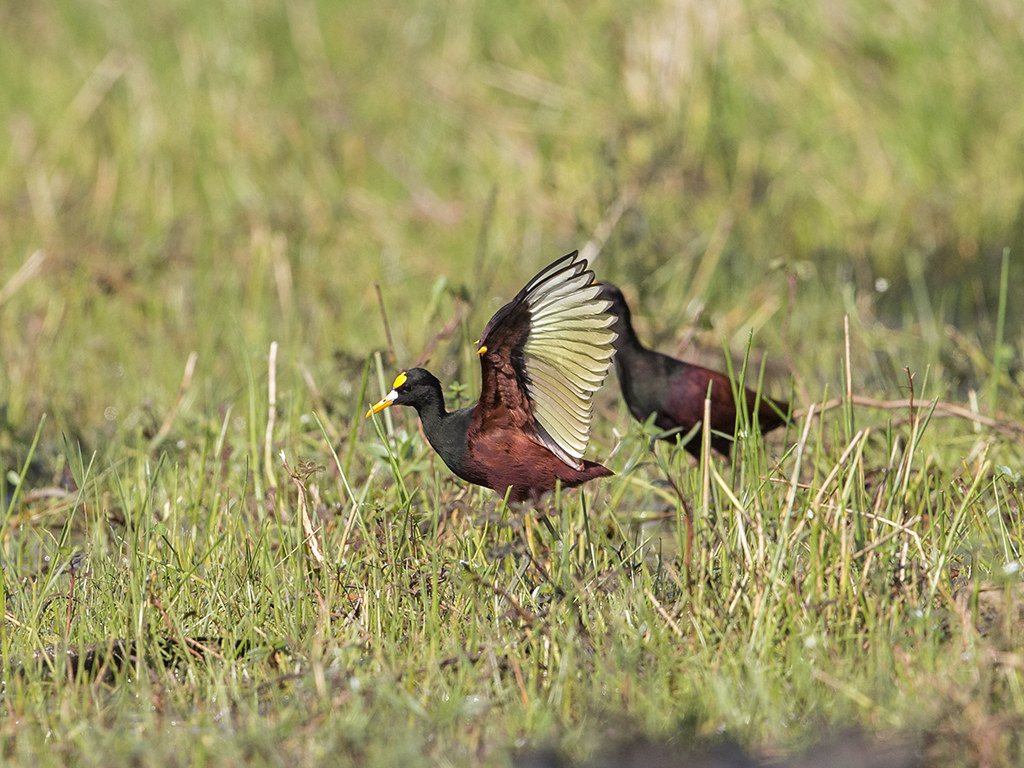 After a brief search Gwilliam found the tree that hopefully was where the Screech Owl might be although there was no guarantee. He told me to get ready as he would knock on the trunk a couple of times.
Sure enough, there at the door to see who was there, our target bird.
After a brief search Gwilliam found the tree that hopefully was where the Screech Owl might be although there was no guarantee. He told me to get ready as he would knock on the trunk a couple of times.
Sure enough, there at the door to see who was there, our target bird.
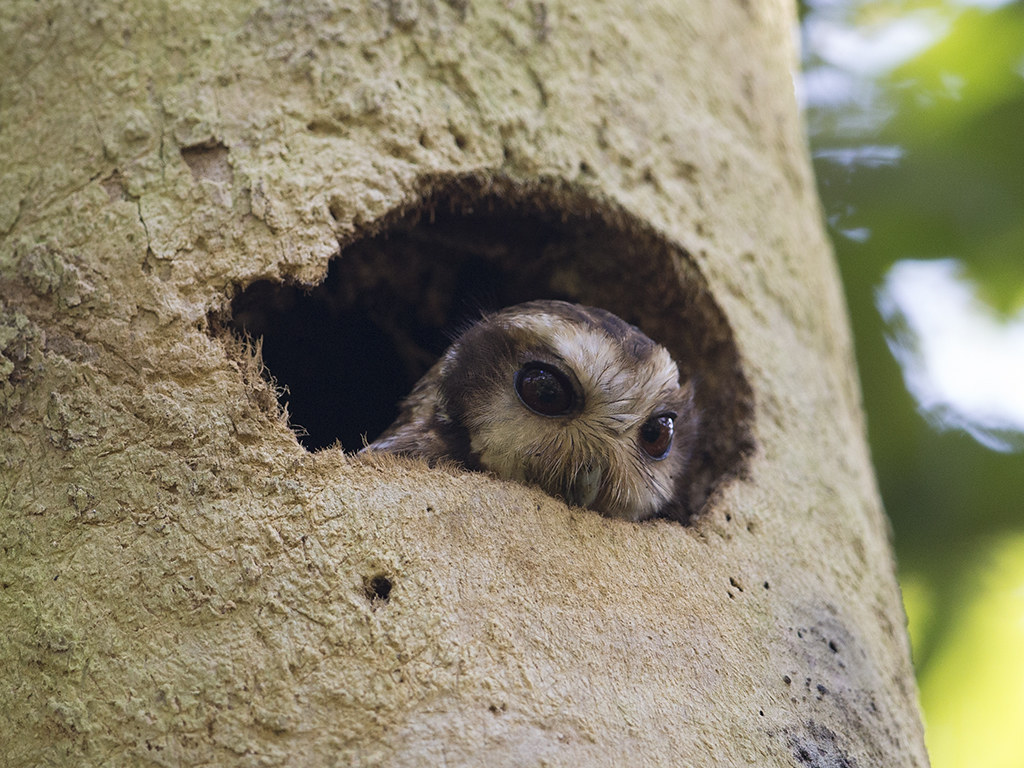 A quick change of position to try for a better shot and we were off to leave it in peace.
A quick change of position to try for a better shot and we were off to leave it in peace.
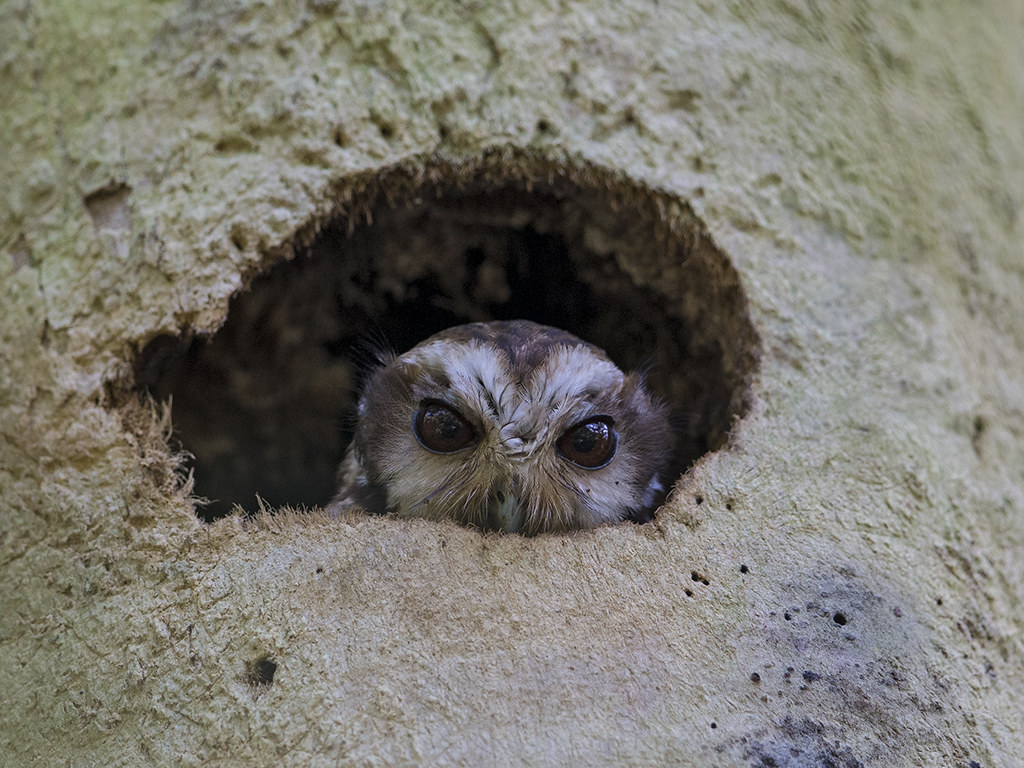 I don't think there will be too many visitors disturbing his sleep.
Anyway, having crossed back over the field we took the car to a previously visited spot by myself. This time we walked some distance out in to another field heading towards some Palm trees out in the middle. We too were in search of the Flicker and from a distance we spied a bird clinging to a tree trunk. Paying more attention to trying to avoid being seen I failed to notice that the ground suddenly changed to pretty wet. Only for a small patch but enough to disappear up to my ankles in mud. All that effort to protect my sandals for nothing! Still we got in to position to view the bird but to my disappointment it was also a West Indian Woodpecker. I wondered if we had been tipped off by the other guide but if so this cast an even bigger doubt on his client's Flicker shot!
Anyway, we walked back towards a patch of lightly wooded field which I had explored the previous evening and, using a caller, we soon had a response. The Flicker flew past us in the woods!
The views were brief but it certainly looked different to a West Indian. Progressing as quietly as possible we followed it's flight path until we found it up a tree offering stunning views.
This was were I made a big mistake and my biggest regret of the holiday, from a photographic perspective anyway. The light wasn't good so instead of just taking some immediate shots I decided to use the tripod I was carrying but by the time I was in position the Flicker had moved. I managed 4 quick shots, all very similar, all revealing a decent image of a headless Fernandina's Flicker before it took off again not to be relocated.
I don't think there will be too many visitors disturbing his sleep.
Anyway, having crossed back over the field we took the car to a previously visited spot by myself. This time we walked some distance out in to another field heading towards some Palm trees out in the middle. We too were in search of the Flicker and from a distance we spied a bird clinging to a tree trunk. Paying more attention to trying to avoid being seen I failed to notice that the ground suddenly changed to pretty wet. Only for a small patch but enough to disappear up to my ankles in mud. All that effort to protect my sandals for nothing! Still we got in to position to view the bird but to my disappointment it was also a West Indian Woodpecker. I wondered if we had been tipped off by the other guide but if so this cast an even bigger doubt on his client's Flicker shot!
Anyway, we walked back towards a patch of lightly wooded field which I had explored the previous evening and, using a caller, we soon had a response. The Flicker flew past us in the woods!
The views were brief but it certainly looked different to a West Indian. Progressing as quietly as possible we followed it's flight path until we found it up a tree offering stunning views.
This was were I made a big mistake and my biggest regret of the holiday, from a photographic perspective anyway. The light wasn't good so instead of just taking some immediate shots I decided to use the tripod I was carrying but by the time I was in position the Flicker had moved. I managed 4 quick shots, all very similar, all revealing a decent image of a headless Fernandina's Flicker before it took off again not to be relocated.
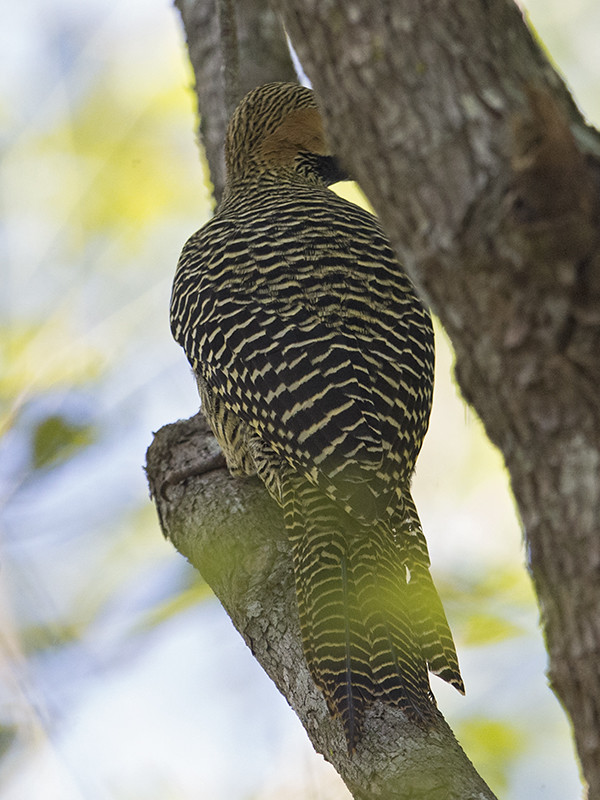 Another endemic, and together with the Owl's head I guess I almost had a complete bird photo.
I went in search many times after but all to no avail. The caller certainly gives a big advantage when it comes to finding a bird in the first place. Guides use them widely and I guess if they are used in moderation and at appropriate times it's OK.
Anyway, my tour came to an end at 1.00pm. Gwilliam had proven to be a good decision, an excellent guide and $35 very well invested. I rounded it off to $40 and he was happy enough it seemed.
So was I.
Seven endemics added to the two I already had gave me 9 out of the possible 21!
T.B.C.
Another endemic, and together with the Owl's head I guess I almost had a complete bird photo.
I went in search many times after but all to no avail. The caller certainly gives a big advantage when it comes to finding a bird in the first place. Guides use them widely and I guess if they are used in moderation and at appropriate times it's OK.
Anyway, my tour came to an end at 1.00pm. Gwilliam had proven to be a good decision, an excellent guide and $35 very well invested. I rounded it off to $40 and he was happy enough it seemed.
So was I.
Seven endemics added to the two I already had gave me 9 out of the possible 21!
T.B.C.
With 10 days to spare, I decided that I would spend the first couple of days just looking around by myself to see how the ground lay and what I could find. Casa owner Tony suggested that I might like to take his brother Arial with me. He's not an official guide and in fact doesn't have too much knowledge of birds, well at least I don't think so. His English is just a bit better than my non existent Spanish!
Seemed like a good idea so off we went. First stop was outside someone's house.
I had heard that there was a garden where you can see the world's smallest bird and here it was. Excellent!
I think it was top of my wanted list. When deciding what photographic gear I was going to take my 600mm lens was a must. I had heard that this tiny little bird likes to perch at the top of a tree.
We walked around the back of the house and there in their yard were a group of about 6 people plus their guide. I'm not sure if they were birders, they all looked at me and my huge lens and tripod like I had just walked in from another planet. Anyway, I soon forgot them and was setting up my gear as there on the flowering bush was a Bee-hummer. Yes ! What a sight!
Then I started to feel stupid.
Whilst I am backing further away from the said bush because it's too close to obtain focus, one of the group has a Go-Pro on a stick and is following the bird around the bush from about a foot away.
I'm not sure if I was irritated by the fact the other person had outsmarted me, my equipment cost a fortune in comparison, or that he was hassling the bird by following it so closely.
To be fair though the bird was used to human presence. The house owners have a nice little earner going on here, indeed the garden has been adapted for tours, and the birds are very confiding.
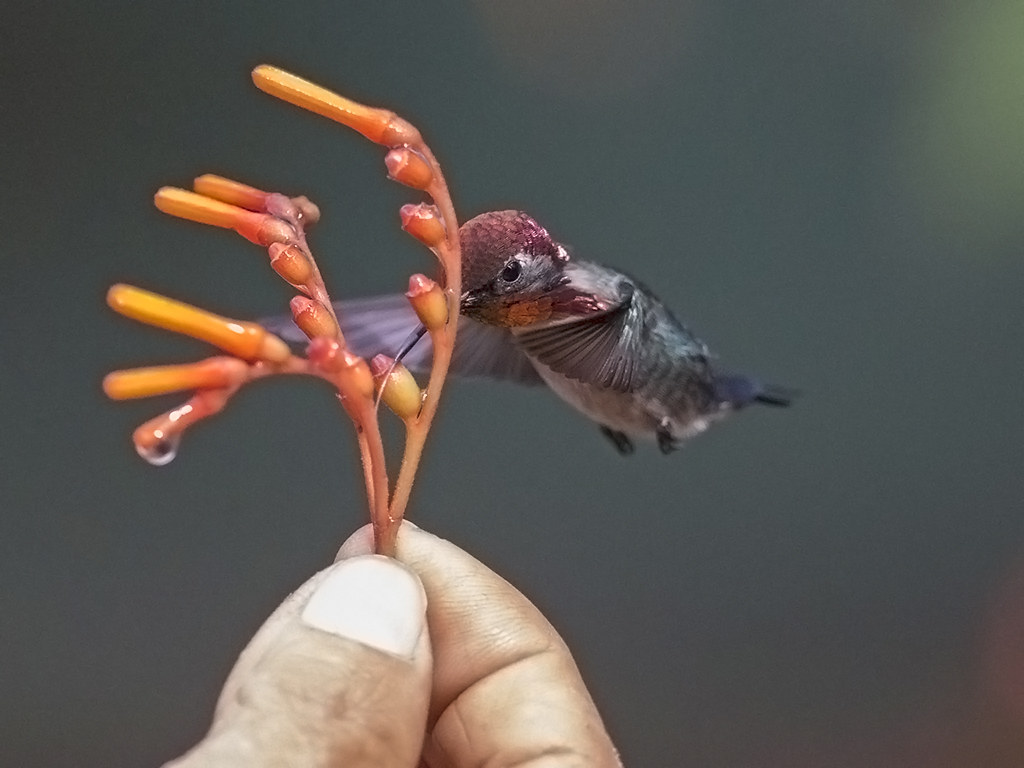 The group didn't stay long but neither did we really. I knew where to come now, very useful indeed, I had the transport and I was told there usually isn't anyone there in the afternoon.
Unhappy with what I had got so far I could return with a smaller more portable lens later and make up for less reach by standing closer!
In total I returned 3 times during the following days and spent a couple of hours on each visit both being entertained and frustrated in equal measure. The birds never showed quite as well as they did on that first visit though.
The group didn't stay long but neither did we really. I knew where to come now, very useful indeed, I had the transport and I was told there usually isn't anyone there in the afternoon.
Unhappy with what I had got so far I could return with a smaller more portable lens later and make up for less reach by standing closer!
In total I returned 3 times during the following days and spent a couple of hours on each visit both being entertained and frustrated in equal measure. The birds never showed quite as well as they did on that first visit though.
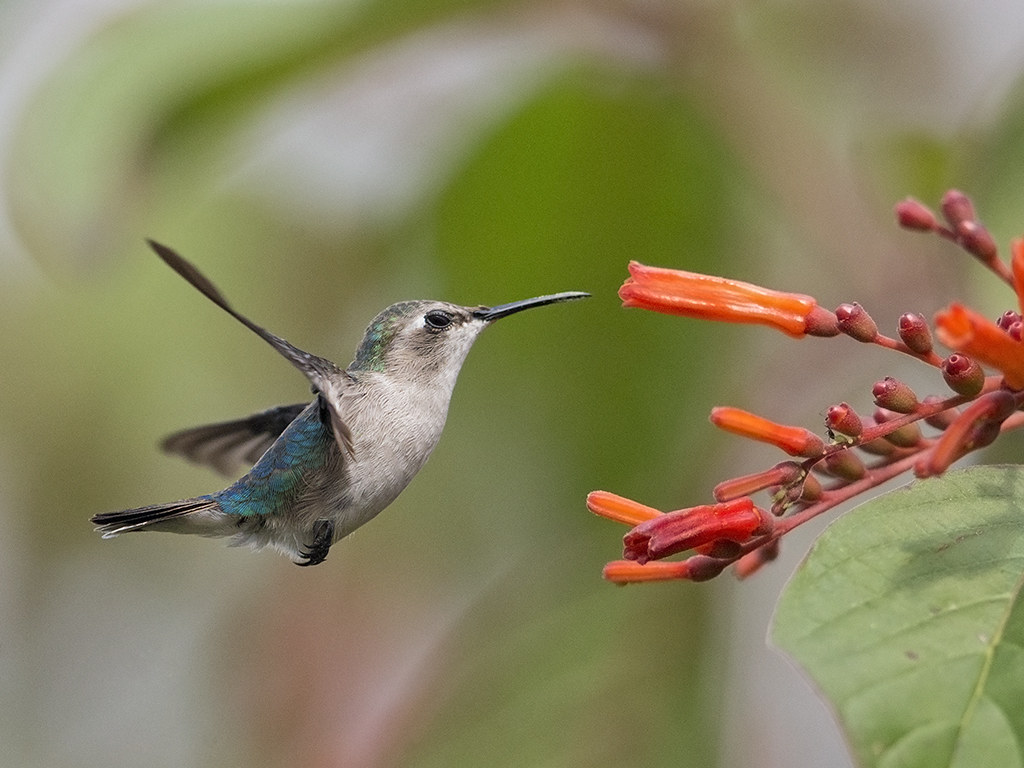 The females appeared to be more numerical.
The females appeared to be more numerical.
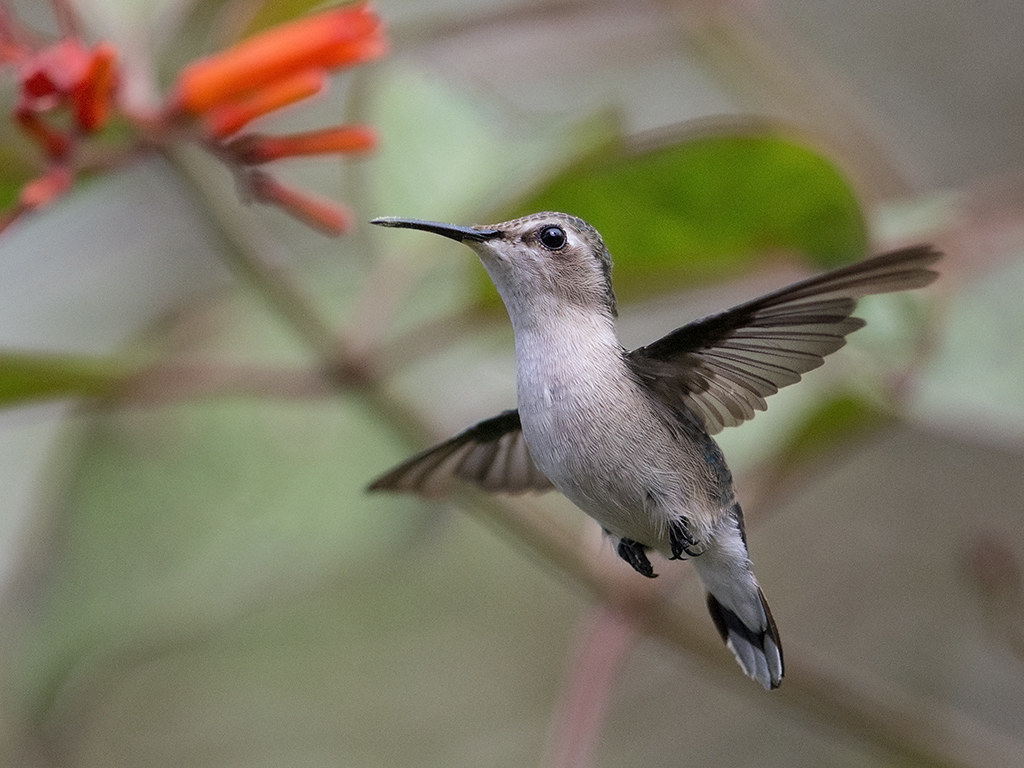 I need to return for another attempt one day though I'm not sure I'm capable of bettering what I achieved..
I need to return for another attempt one day though I'm not sure I'm capable of bettering what I achieved..
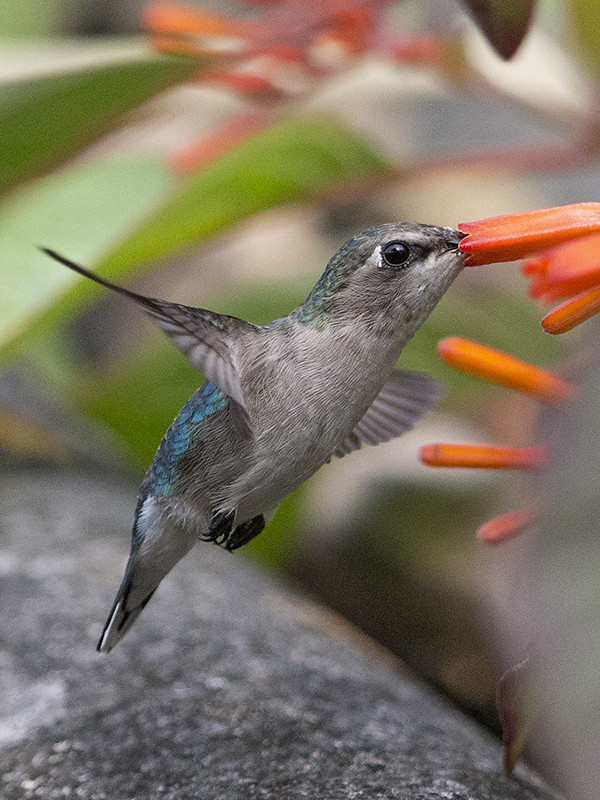 I'm only showing you the few that came out ! I think I need to take a notebook or laptop on my travels next time. What looks OK on the back of the camera doesn't on a big screen.
The Hummers move so fast you need the fastest shutter speed you can muster, trouble is if the light isn't brilliant you need to compensate. You end up with the lens wide open and loose depth of field even on a tiny bird. You also need to settle for high ISO and the noise that comes with it.
I'm only showing you the few that came out ! I think I need to take a notebook or laptop on my travels next time. What looks OK on the back of the camera doesn't on a big screen.
The Hummers move so fast you need the fastest shutter speed you can muster, trouble is if the light isn't brilliant you need to compensate. You end up with the lens wide open and loose depth of field even on a tiny bird. You also need to settle for high ISO and the noise that comes with it.
 See what I mean?
See what I mean?
 Just occasionally the male bird would sit in the bush, the females did so regularly, but the bush also attracted Cuban Emeralds and they were quick to see off the opposition if given a chance. The male returned to the top of a nearby tree.
Just occasionally the male bird would sit in the bush, the females did so regularly, but the bush also attracted Cuban Emeralds and they were quick to see off the opposition if given a chance. The male returned to the top of a nearby tree.
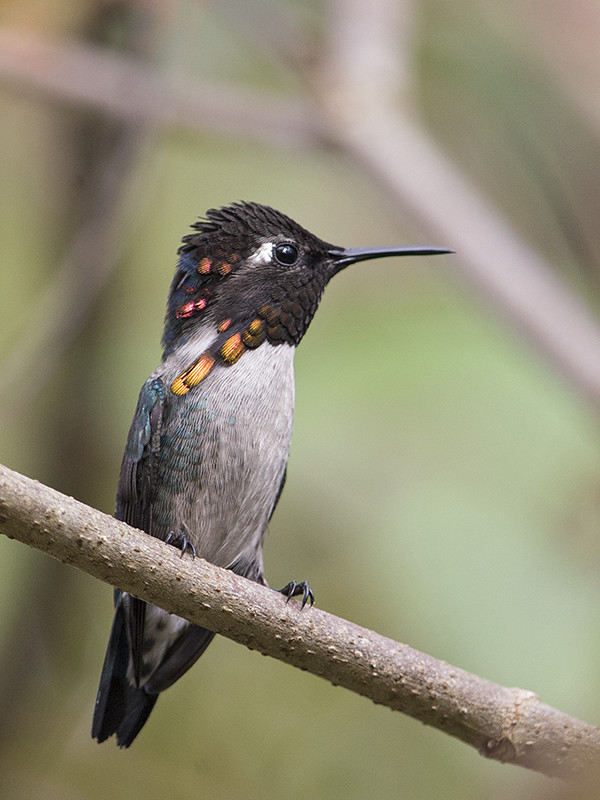 Indeed the male is a very handsome bird compared to the female. If the light catches the plumage in a certain direction the change in appearance is stunning.
Indeed the male is a very handsome bird compared to the female. If the light catches the plumage in a certain direction the change in appearance is stunning.
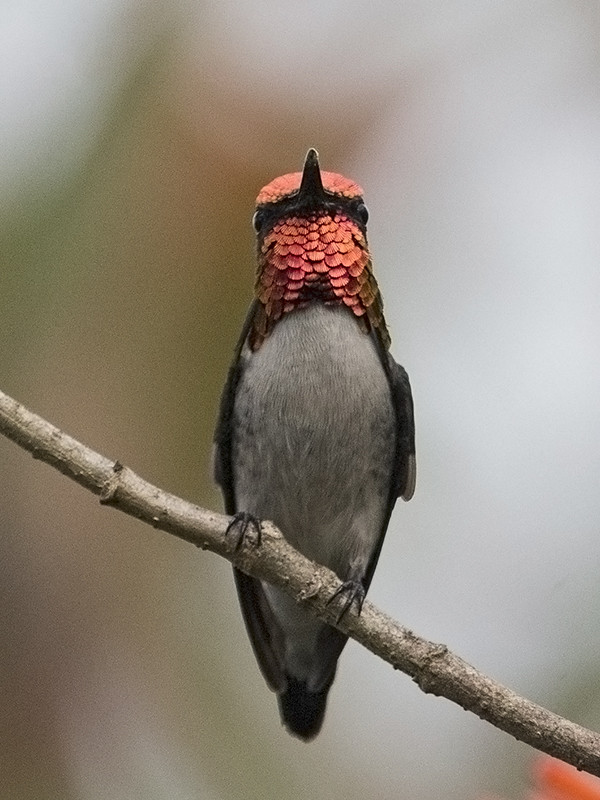
Anyway, I might add some more shots later in the blog, but back to that Monday a few weeks ago, Arial directed me back towards Sopillar, somewhere I was already familiar with but of course he knew some different spots. We headed off down a farm track and after exchanging pleasantries with the farmers, who he knew, we walked out to the edge of a large heavily flooded field. In the distance American Coots and Northern Jacanas.
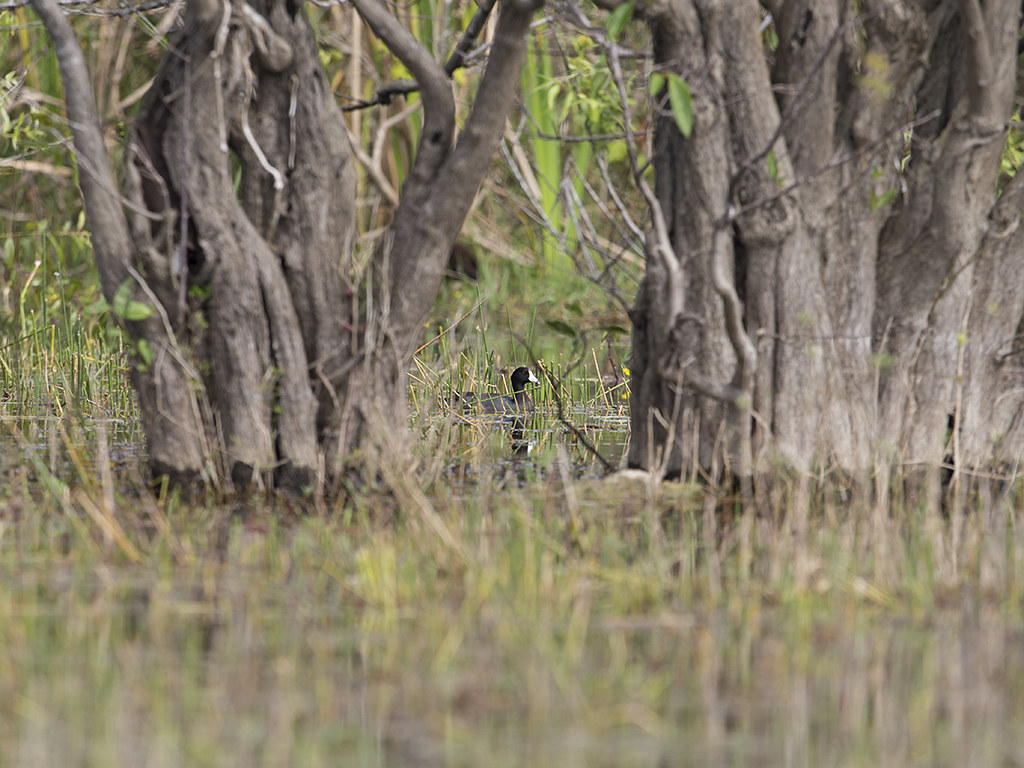 They were too far away to get a decent shot and also seemed very nervy and took to the air if they saw us, even at considerable distance.
A pair of Killdeer were less so.
They were too far away to get a decent shot and also seemed very nervy and took to the air if they saw us, even at considerable distance.
A pair of Killdeer were less so.
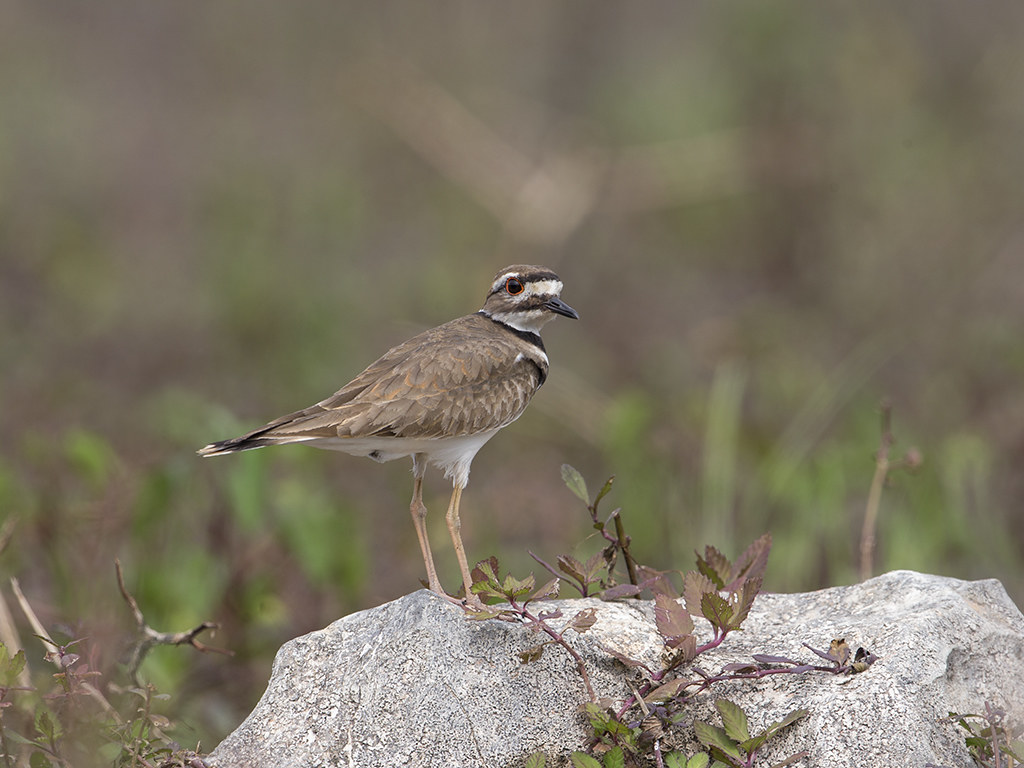 Moving on I discovered what Arial was keen to show me.
Moving on I discovered what Arial was keen to show me.
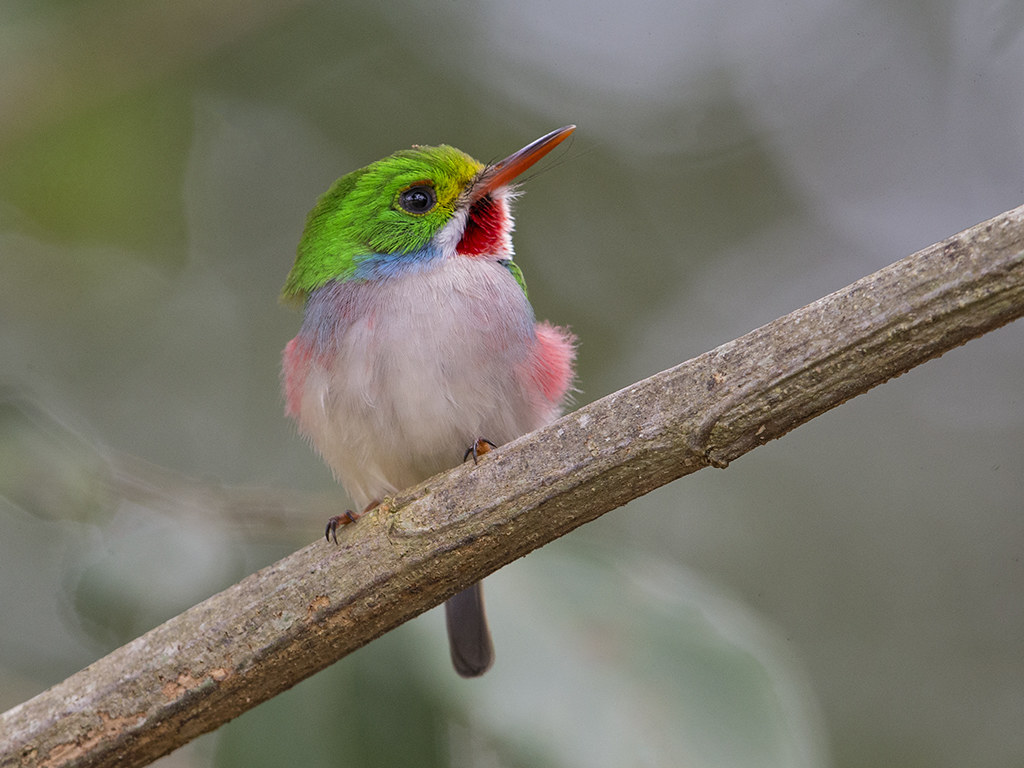 What a gorgeous little bird, in fact there was a pair and they nest in a nearby tree although not as yet this year.
Along with the Bee Hummingbird and Cuban Trogan and Parrot, the Cuban Today was a top,top target.
What a gorgeous little bird, in fact there was a pair and they nest in a nearby tree although not as yet this year.
Along with the Bee Hummingbird and Cuban Trogan and Parrot, the Cuban Today was a top,top target.
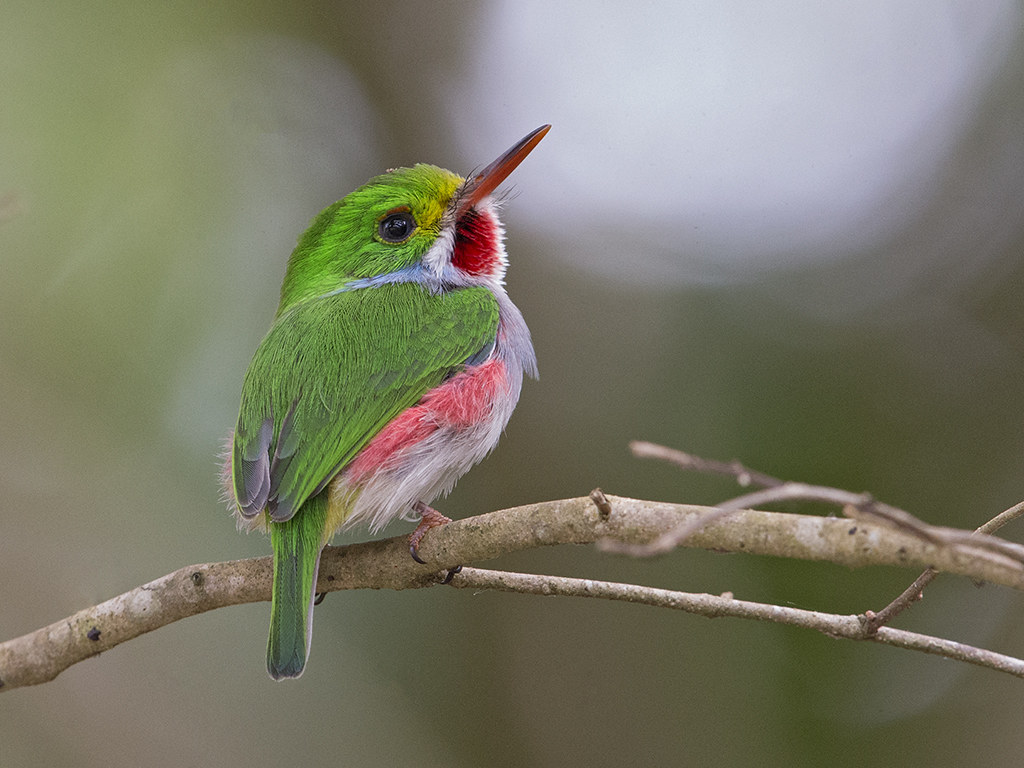 I think of all the birds I saw this has to be the favourite. As pretty and delicate as a ballerina.
I spent ages trying to get the perfect shot but Arial was more than happy to hang around watching or having a smoke.
We had one more bird to add to the list before we called it a day.
On the floor of a muddy bit of woodland, an Ovenbird.
I think of all the birds I saw this has to be the favourite. As pretty and delicate as a ballerina.
I spent ages trying to get the perfect shot but Arial was more than happy to hang around watching or having a smoke.
We had one more bird to add to the list before we called it a day.
On the floor of a muddy bit of woodland, an Ovenbird.
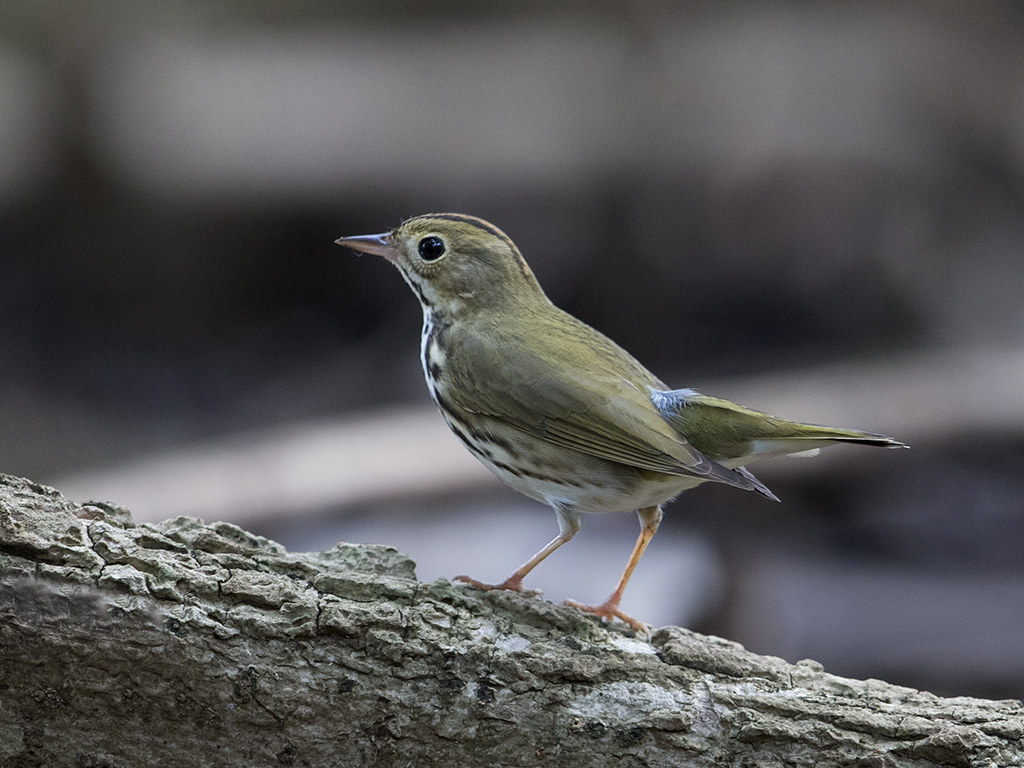 It had been a few hours well spent and I gave Arial 15 CUC ( the tourist currency 1= $1 U.S.) to supplement his wage as a fisherman.
I also decided it probably made more sense to take a pro guide sooner than later. That way I'd know what was left to find with the days remaining.
Tony arranged for one to come around to see me the following morning and we could discuss my target birds.
Seemed like a good idea!
T.B.C.
It had been a few hours well spent and I gave Arial 15 CUC ( the tourist currency 1= $1 U.S.) to supplement his wage as a fisherman.
I also decided it probably made more sense to take a pro guide sooner than later. That way I'd know what was left to find with the days remaining.
Tony arranged for one to come around to see me the following morning and we could discuss my target birds.
Seemed like a good idea!
T.B.C.
With 5 nights gone it was time to move on from Moron to head south west to Playa Larga at the top of the Bay of Pigs, or Bahia de Cochinos to give it it's correct title. This was the bit I was really looking forward to. Hopefully a birding hotspot, located right next door to the Zapata swamp/ national park. The N.P. offices are based there so getting a guide as and when required should be simple enough. In fact my emails to try and book two of the most well known had basically referred me there as they were booked up ( and that was months in advance).
It's a fair old journey from Moron, about 350 kms so we left fairly early taking the scenic route with the intention of stopping off in Santa Clare to visit the Che monument.
 Impressive it is. Huge and must have cost a fortune along with the whole arena it is built in. Apparently 500,000 locals volunteered to help in the construction. As an 18 year old Che was a bit of a hero to me, I had the poster on the wall although I hadn't got a clue about him or what he really stood for. Student ideals eh!
After Santa Clara we picked up the three lane Autopsista Nationale which would have taken us all the way to Havana had we not come off at Jaguey Grande to drop down to Playa Larga.
The Autopsista is 3 lanes for much of the way and it was probably the weirdest diving experience I have had. With a speed limit of 110kph ( just under 70mph) you can put your foot down a bit but you have to be prepared for one or two pot holes as usual. There isn't a crash central barrier in much of the road but the odds on something crossing over from the other side is fairly small I would imagine basically because there is no traffic at all.
Impressive it is. Huge and must have cost a fortune along with the whole arena it is built in. Apparently 500,000 locals volunteered to help in the construction. As an 18 year old Che was a bit of a hero to me, I had the poster on the wall although I hadn't got a clue about him or what he really stood for. Student ideals eh!
After Santa Clara we picked up the three lane Autopsista Nationale which would have taken us all the way to Havana had we not come off at Jaguey Grande to drop down to Playa Larga.
The Autopsista is 3 lanes for much of the way and it was probably the weirdest diving experience I have had. With a speed limit of 110kph ( just under 70mph) you can put your foot down a bit but you have to be prepared for one or two pot holes as usual. There isn't a crash central barrier in much of the road but the odds on something crossing over from the other side is fairly small I would imagine basically because there is no traffic at all.
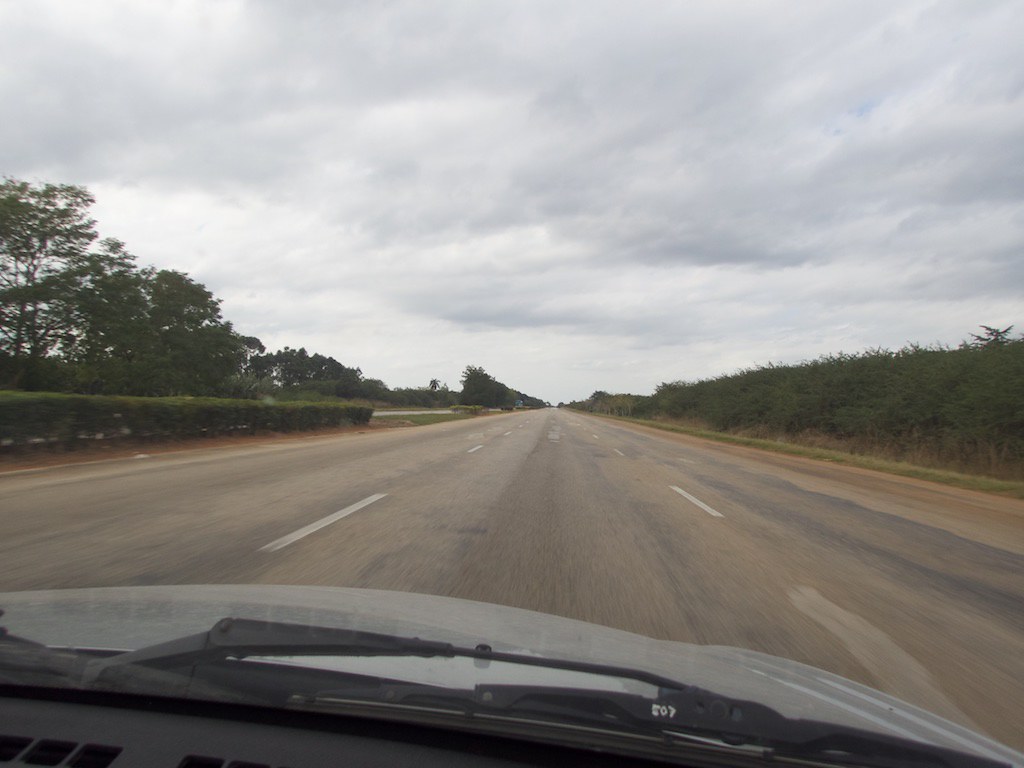
What joy. I'm hogging the centre lane to a) give me options if there is a pot hole ahead, b) avoid the occasional pedestrian who appears in the fast lane trying to flag you down to buy cheese! Why are they in the fast lane? Obvious, so they can cover both directions at once as there are few cars to try an attract.
So, swerving this way and that at higher speed, we got to Playa Larga sooner than expected, probably around 4.00pm, and were immediately feeling right at home. What a lovely couple run our chosen Casa. The extremely charming Tony and Osmara have previous experience working in the hotel industry and it shows. They currently only have two rooms available in what was the family house handed down from grandfather who claimed the plot when it was still a swamp but now it's the most envied location in PL and everyday we witnessed them turning away potential enquirers.Hugely beneficial to us was that they speak perfect English too!
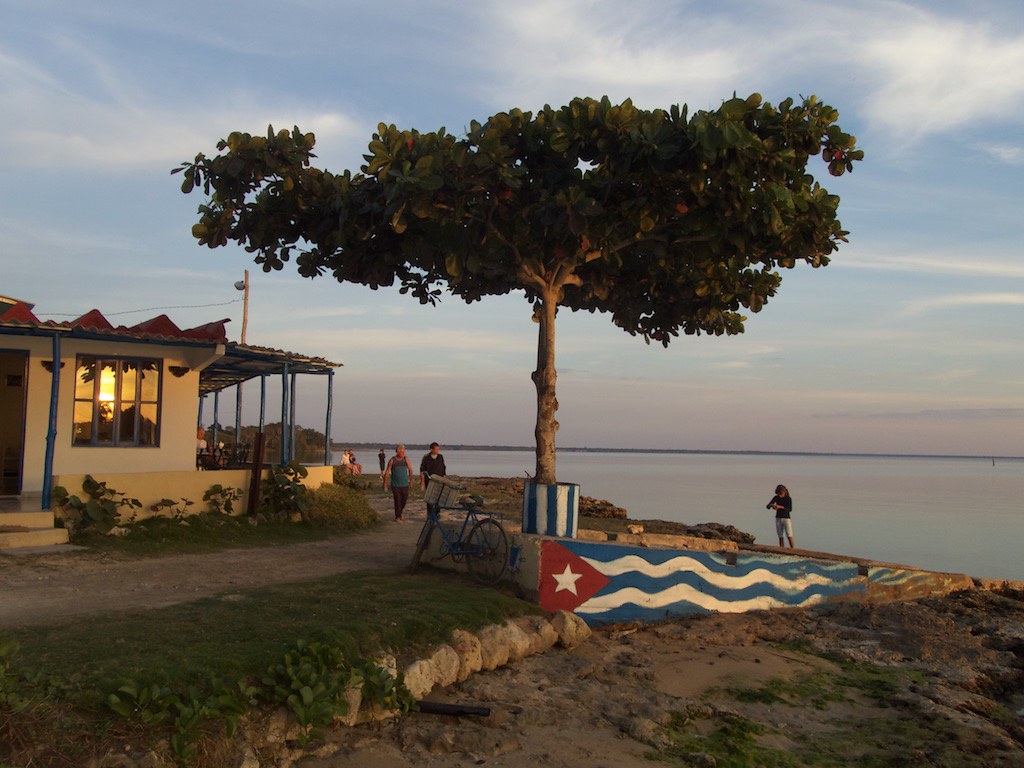 The tree in front of their home must be one of the most photographed in Cuba if not anywhere. At sunset quite a few people would turn up to snap the shot, complete with Tony's bike !
As for us, well what a spot to sunbathe for Claire during the day, Mojitos and beers at night.
The tree in front of their home must be one of the most photographed in Cuba if not anywhere. At sunset quite a few people would turn up to snap the shot, complete with Tony's bike !
As for us, well what a spot to sunbathe for Claire during the day, Mojitos and beers at night.
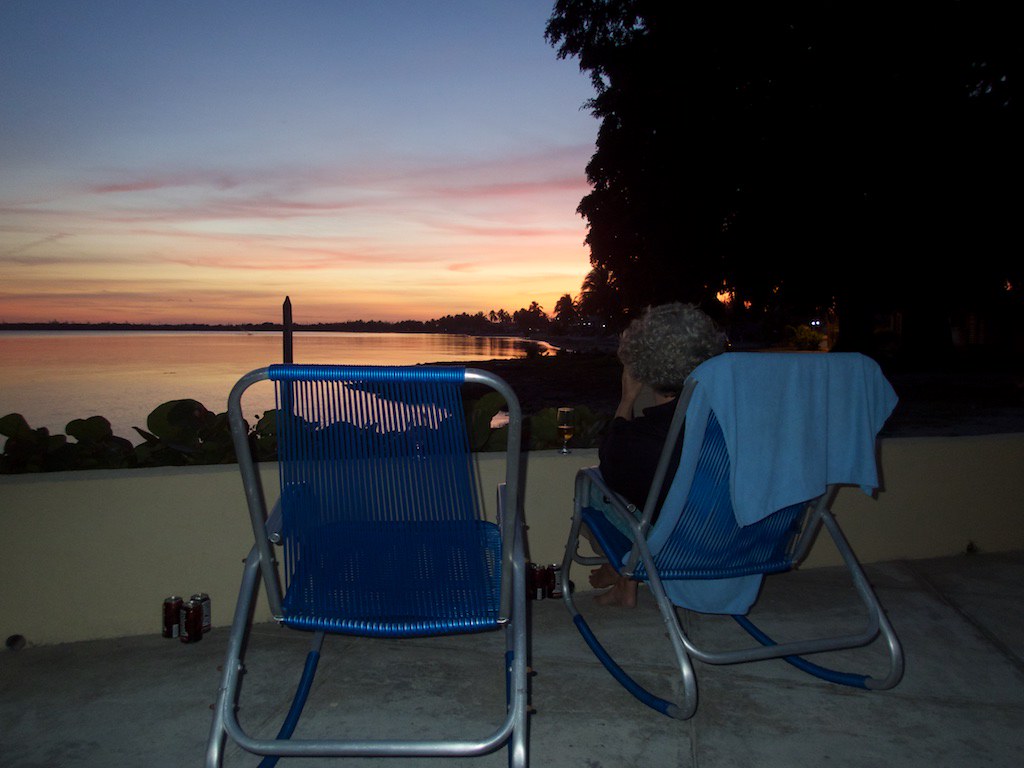 Meals are taken on the wrap around covered patio as seen in the first shot. You are feet from the sea which is warm and has some excellent snorkelling right there.
No doubt you are starting to get the picture. It's the ideal spot for a birder/non birder couple who just want to chill.
Heaven!
Osmara told us she was worried we'd be bored having booked 10 days, most folk stay a day or two.
We certainly weren't and I'll tell you why in a page or two!
Meals are taken on the wrap around covered patio as seen in the first shot. You are feet from the sea which is warm and has some excellent snorkelling right there.
No doubt you are starting to get the picture. It's the ideal spot for a birder/non birder couple who just want to chill.
Heaven!
Osmara told us she was worried we'd be bored having booked 10 days, most folk stay a day or two.
We certainly weren't and I'll tell you why in a page or two!
After settling in I was itching to get out but with just an hour or so of light left I left Claire and just drove through the village and up an unmade road I found. The swamp was on either side so I was on the fringe of the National Park. In fact after a few hundred metres I arrived at the barrier of the now closed entrance point. I just kerb crawled the mangroves until first I found yet another Cuban Pewee... I was to discover how common they actually are as time went by..... and both an American Redstart and Grey Catbird which were neither as confiding or stationary as the Pewee.
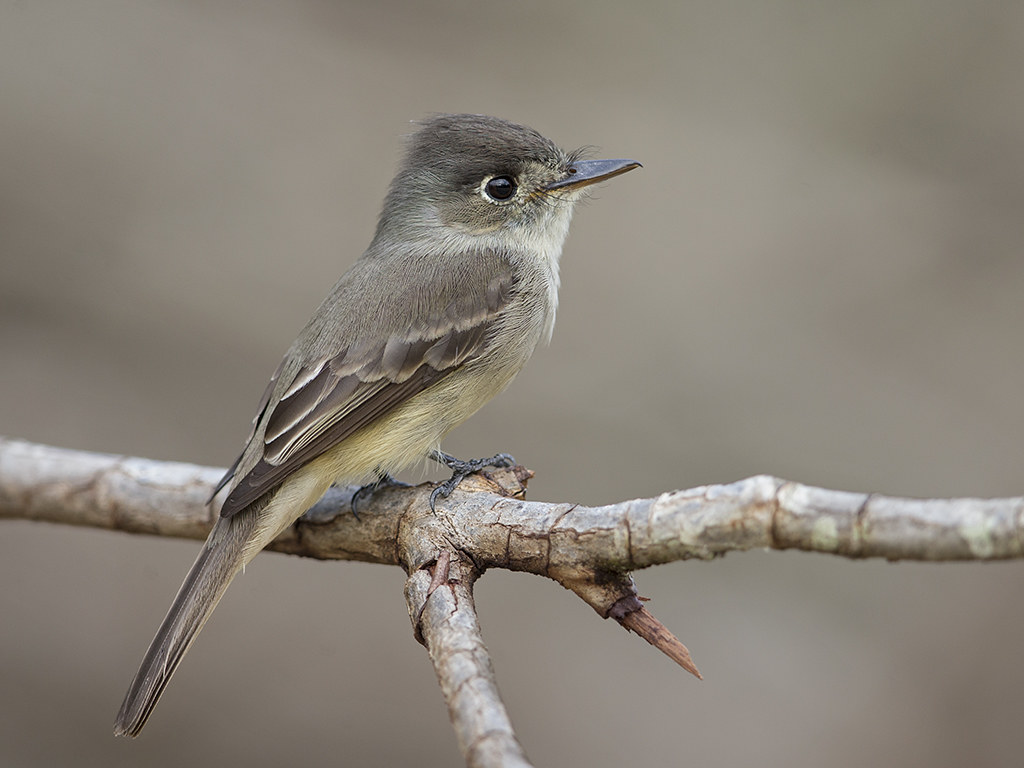 Disappointed at failing to capture all three on camera I wasn't to know I'd see plenty more!
What I did learn was that the mosquitos were very active on the edge of the swamp. It was my first and final visit to that stretch of track.
Ordering a later breakfast I was off again first thing, this time to the village of Sopillar just a few miles away but outside of the park and in the middle of a wooded and agricultural area.
I was soon on to a Northern Mockingbird posing rather nicely.
Disappointed at failing to capture all three on camera I wasn't to know I'd see plenty more!
What I did learn was that the mosquitos were very active on the edge of the swamp. It was my first and final visit to that stretch of track.
Ordering a later breakfast I was off again first thing, this time to the village of Sopillar just a few miles away but outside of the park and in the middle of a wooded and agricultural area.
I was soon on to a Northern Mockingbird posing rather nicely.
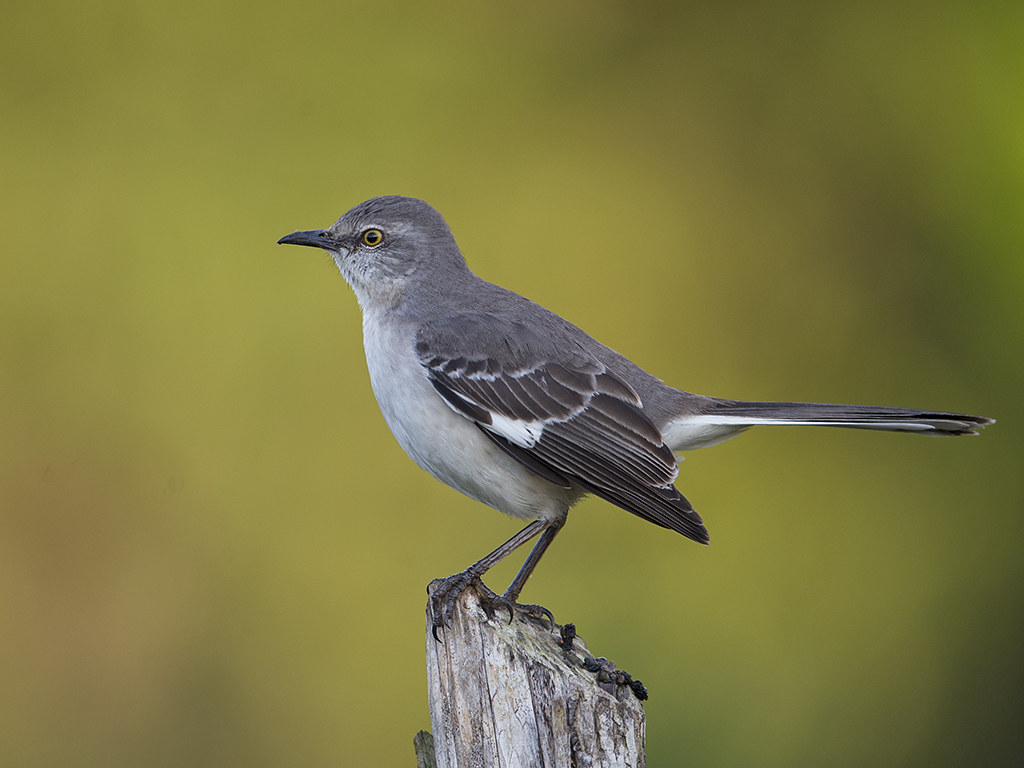 Better still a West Indian Woodpecker which I had been watching at the top of an electricity pole flew down to make an even better shot clinging on to a banana flower.
Better still a West Indian Woodpecker which I had been watching at the top of an electricity pole flew down to make an even better shot clinging on to a banana flower.
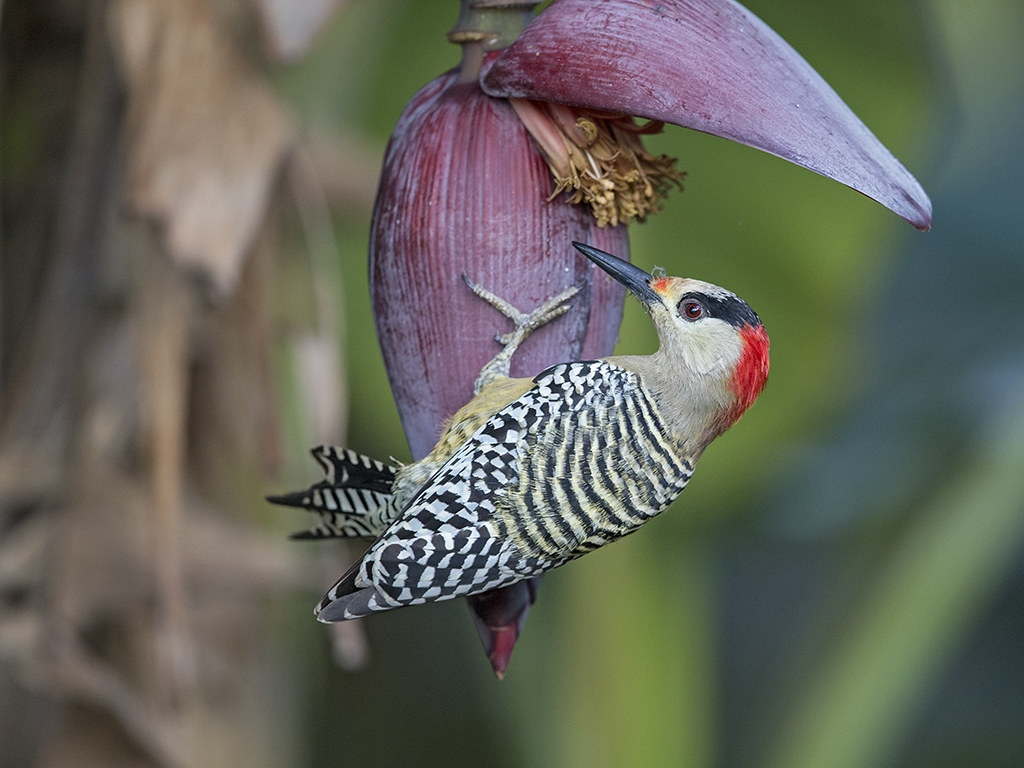 This was more like it !
A Palm Warbler was soon forgotten in favour of an American Kestrel
This was more like it !
A Palm Warbler was soon forgotten in favour of an American Kestrel
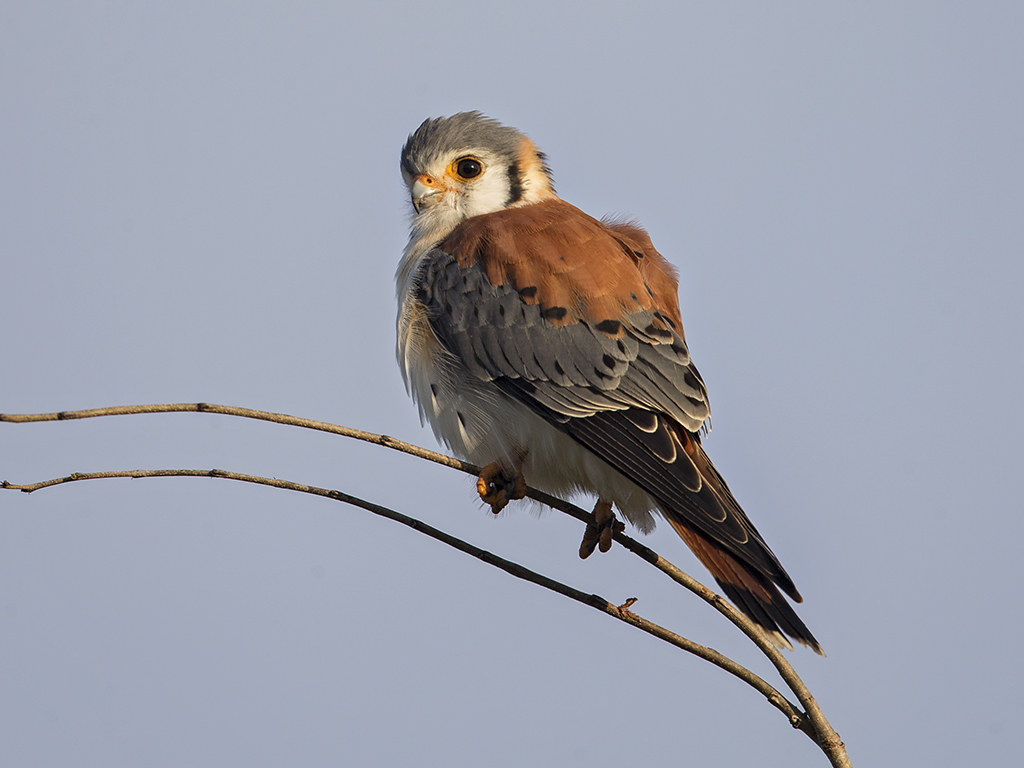 then I spent hours, well seemed like, trying to get a decent shot of the Great Lizard Cuckoo which was always on the move and semi obscured.
then I spent hours, well seemed like, trying to get a decent shot of the Great Lizard Cuckoo which was always on the move and semi obscured.
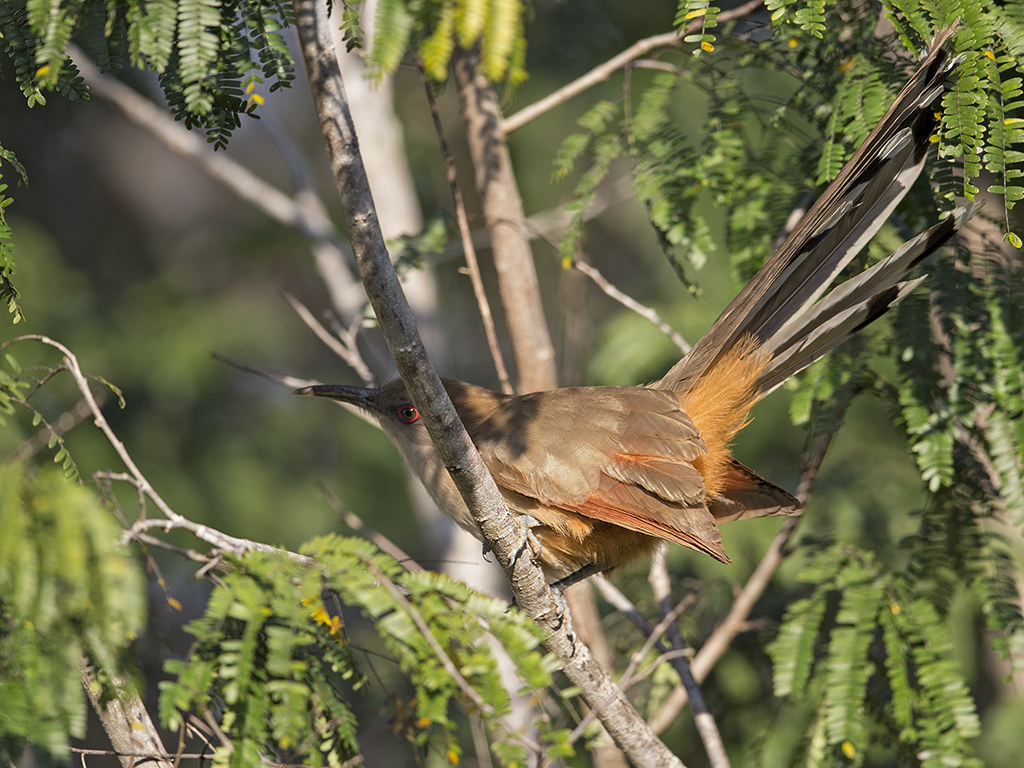 Eventually I settled for this one.
Eventually I settled for this one.
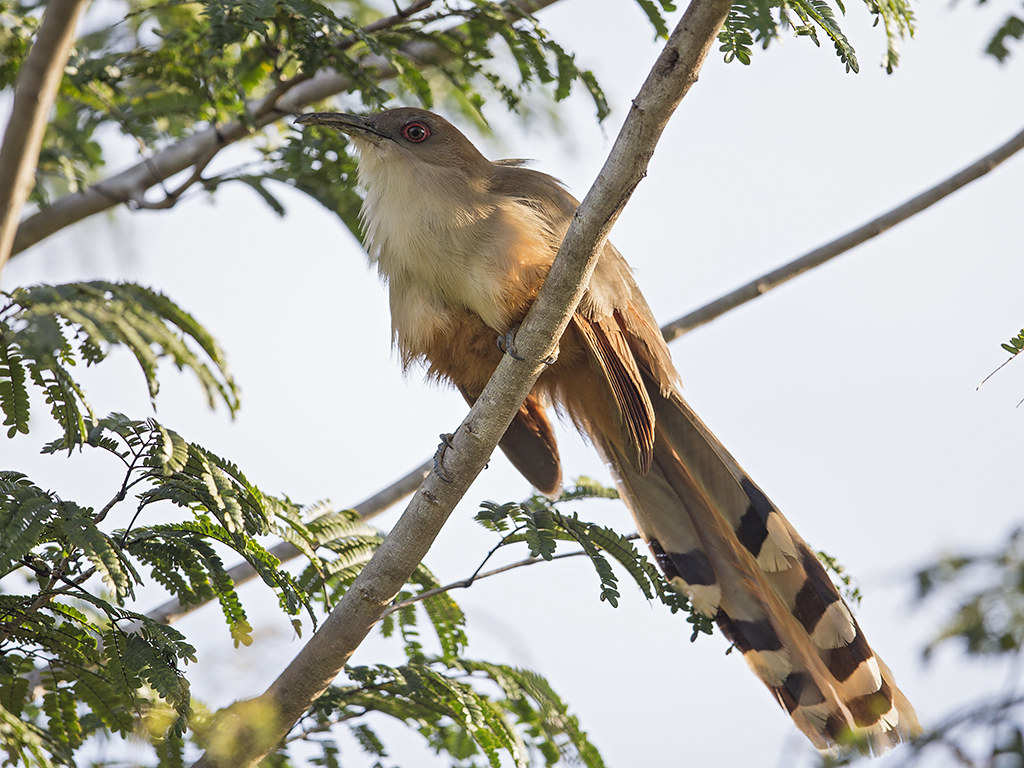 It was soon time to return for breakfast but the fun wasn't over, as I was leaving the village I heard Parrots calling so I stopped the car. One of the villagers beckoned me over, then invited me in to his back garden.
How good was this!
It was soon time to return for breakfast but the fun wasn't over, as I was leaving the village I heard Parrots calling so I stopped the car. One of the villagers beckoned me over, then invited me in to his back garden.
How good was this!
 They were feeding just a few feet away from me.
They were feeding just a few feet away from me.
 My biggest problem was I was too close with a 600mm lens!
I had to go, I was already a little late for breakfast but there was still a surprise when I got back. A regular visitor right in front of the Casa was this Little Blue Heron
My biggest problem was I was too close with a 600mm lens!
I had to go, I was already a little late for breakfast but there was still a surprise when I got back. A regular visitor right in front of the Casa was this Little Blue Heron
 I returned to Sopillar that evening, this time adding more shots of Loggerhead Kingbird
I returned to Sopillar that evening, this time adding more shots of Loggerhead Kingbird
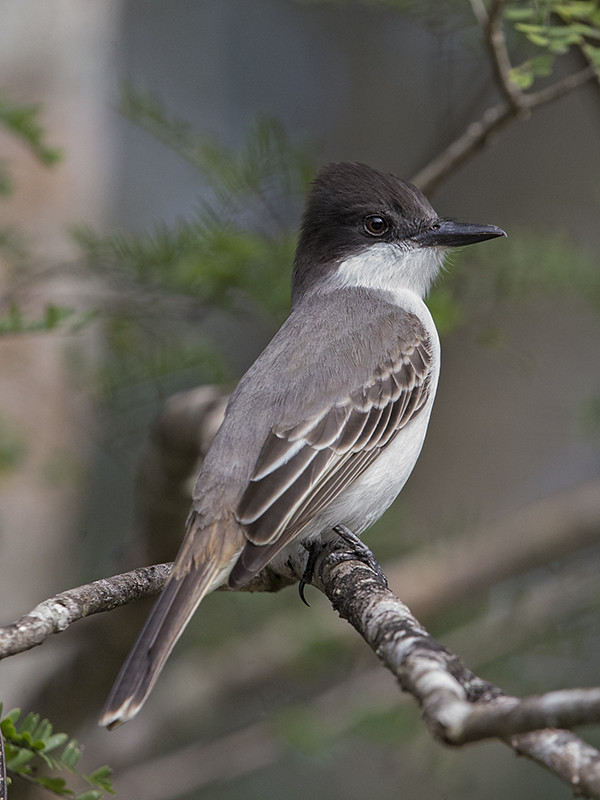 and Shiny Cowbird
and Shiny Cowbird
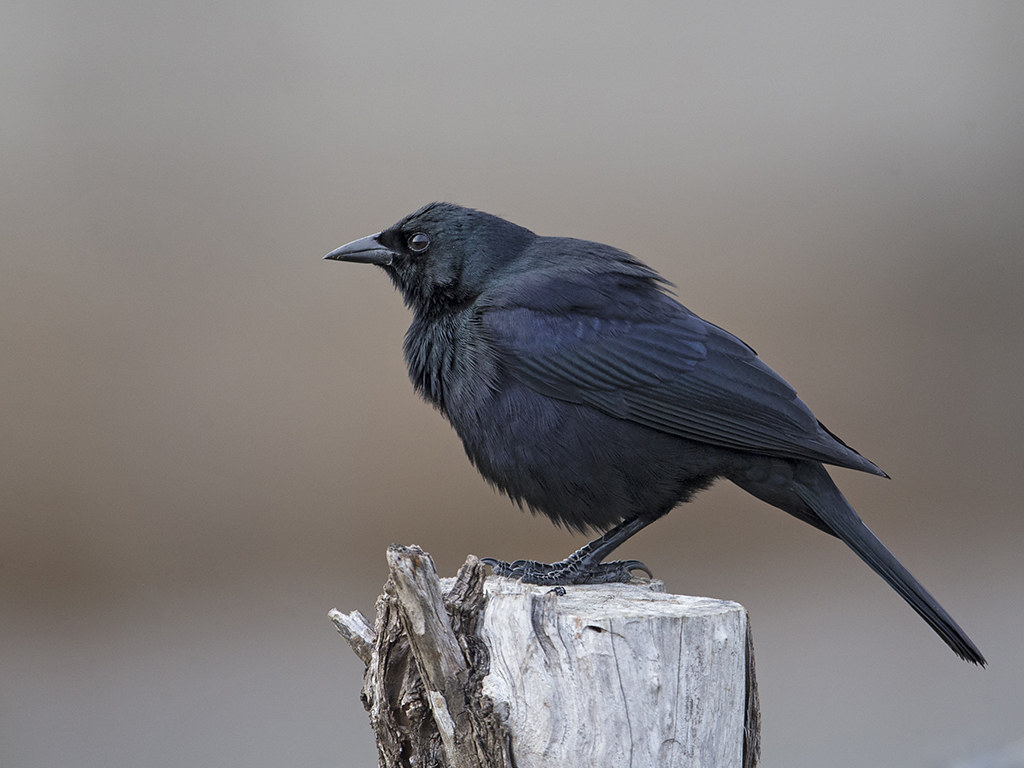 but that was about it.
Not a bad full first day though eh?
Not sure which was my highlight, the Woodpecker
but that was about it.
Not a bad full first day though eh?
Not sure which was my highlight, the Woodpecker
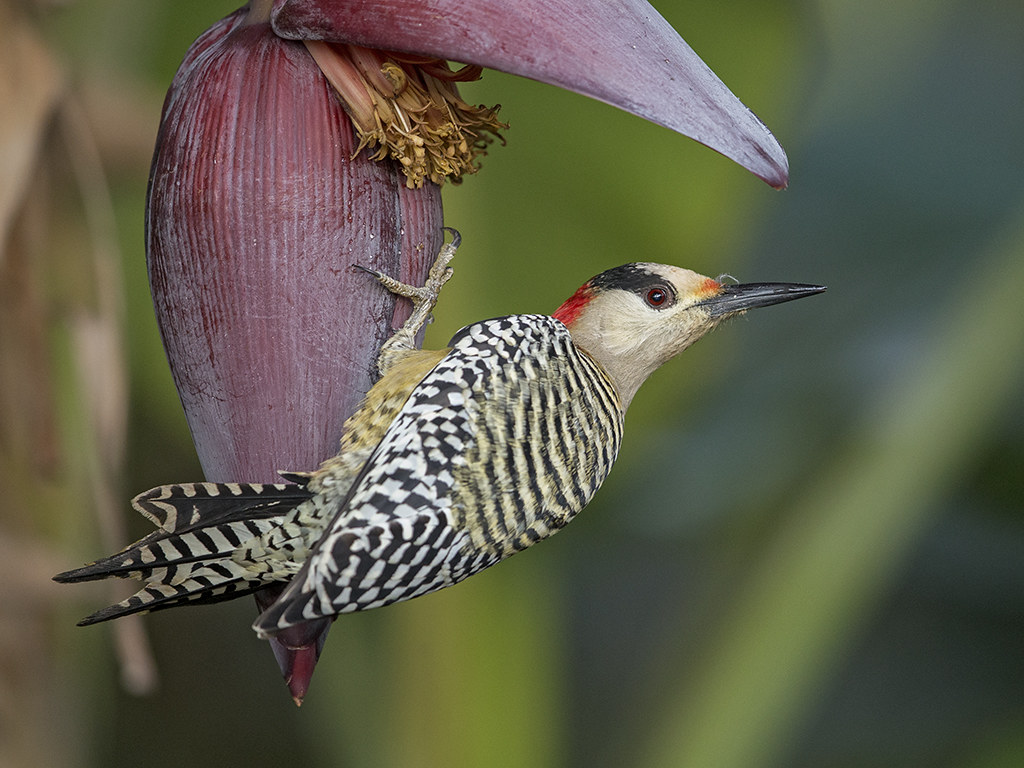 or the Parrot ?
or the Parrot ?
Has to be the Cuban Parrot.
How often do you get that close ? I didn't get another opportunity again, actually I tell a lie. I did.
Sadly this highly at risk species is dwindling in numbers fast and one of the prime reasons is the number that have been and still are being taken in the wild as pets. To make matters worse, to catch the fledgling birds the tree they nest in is chopped down to get them. That not only reduces number currently but also in the future as nesting sites are denied not just parrots but other birds too.
What a day though, lets leave on a high note. A wild Cuban Parrot where it should be, up a tree not in a tiny cage.
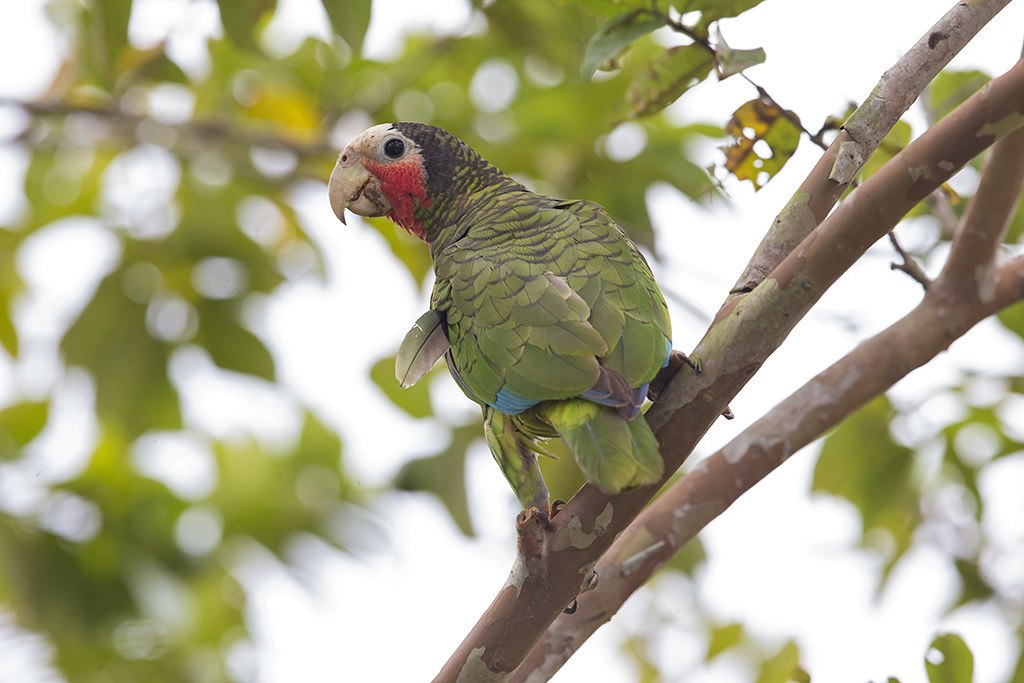
T.B.C.


















































